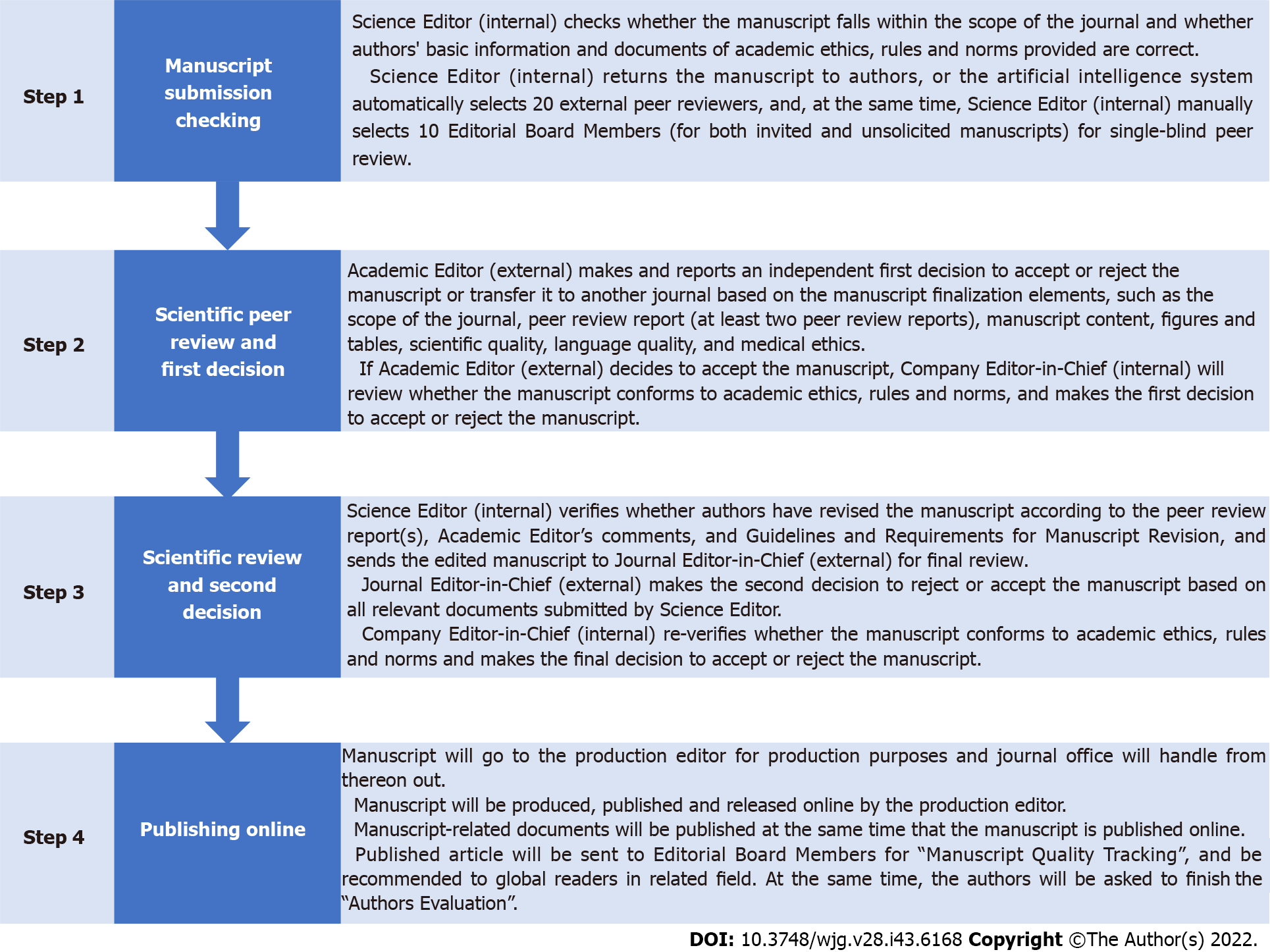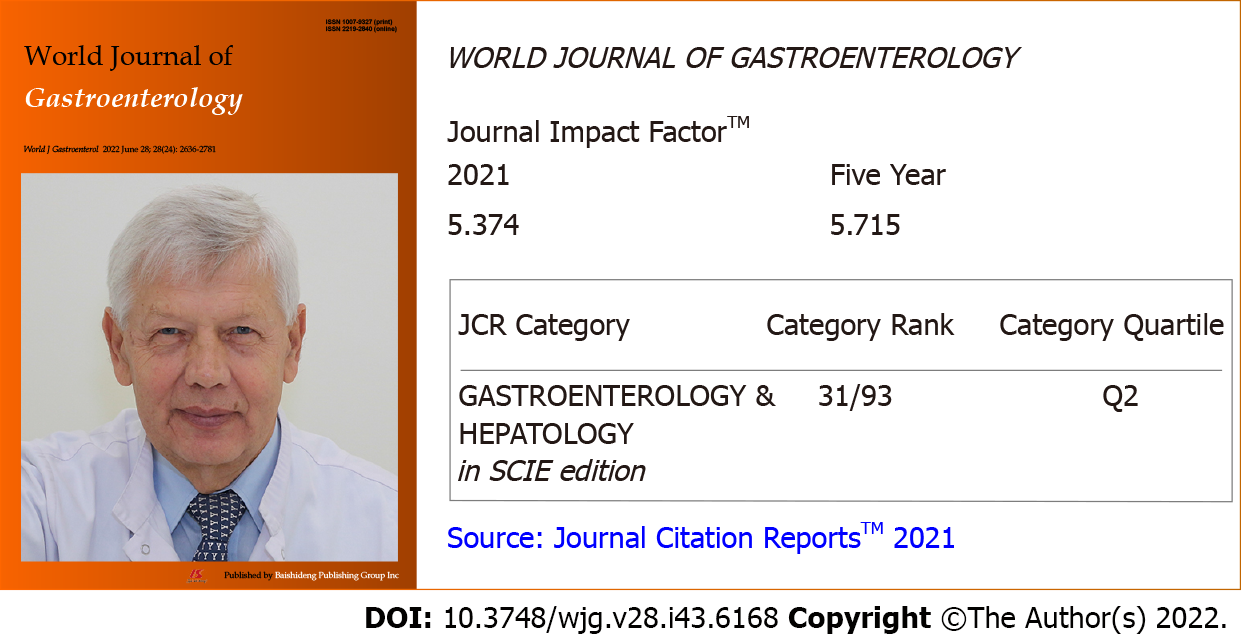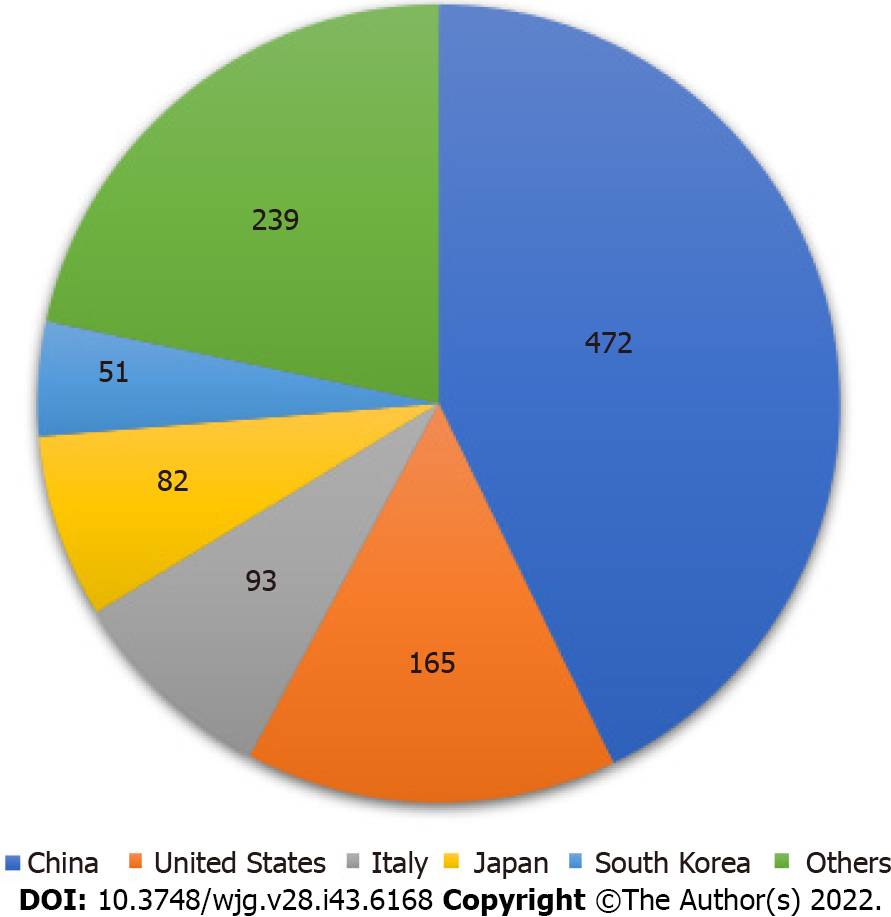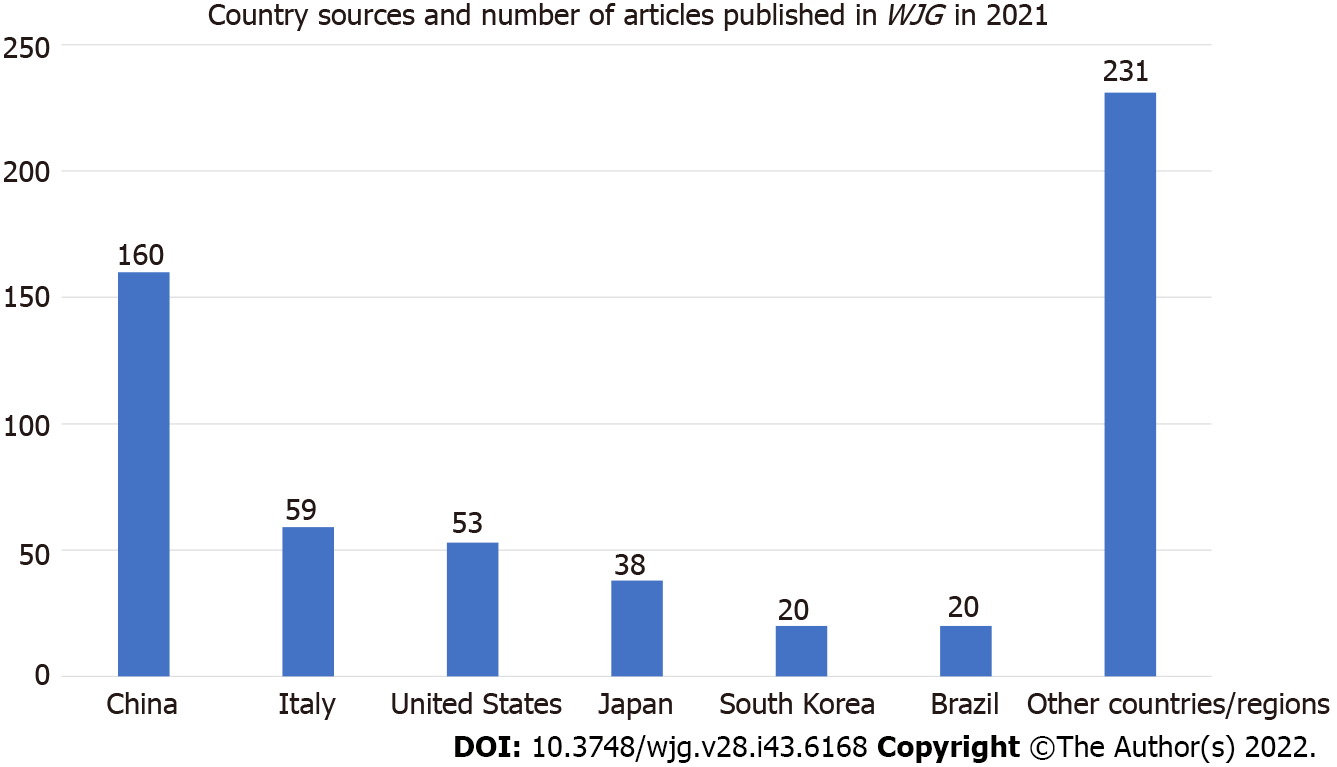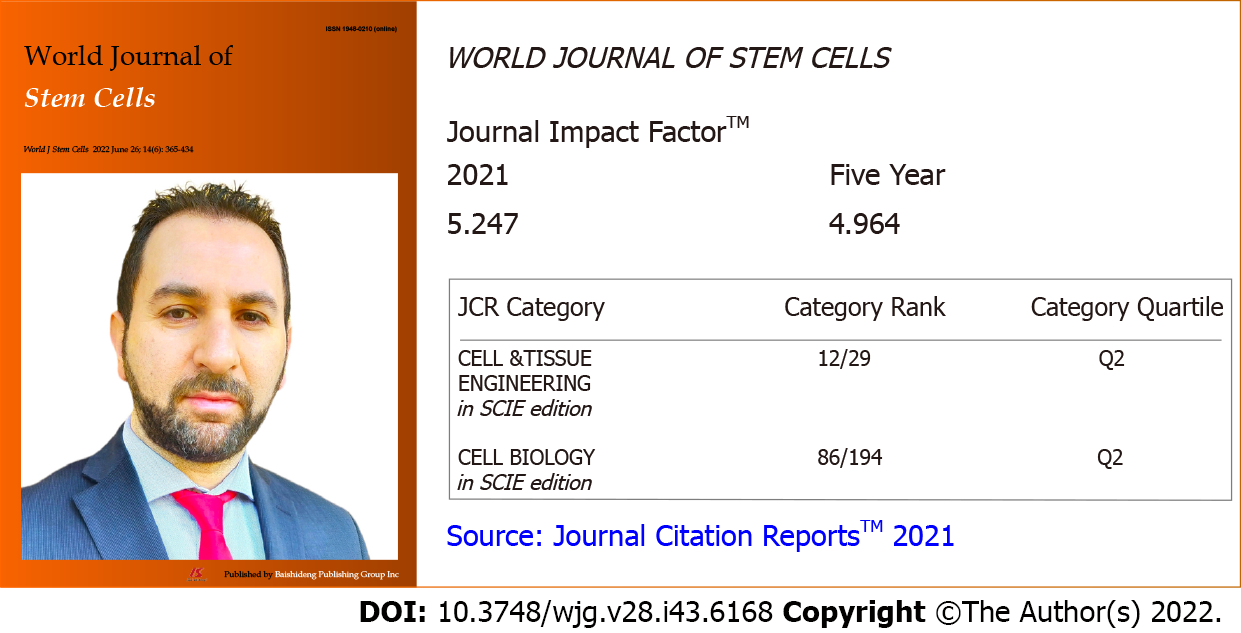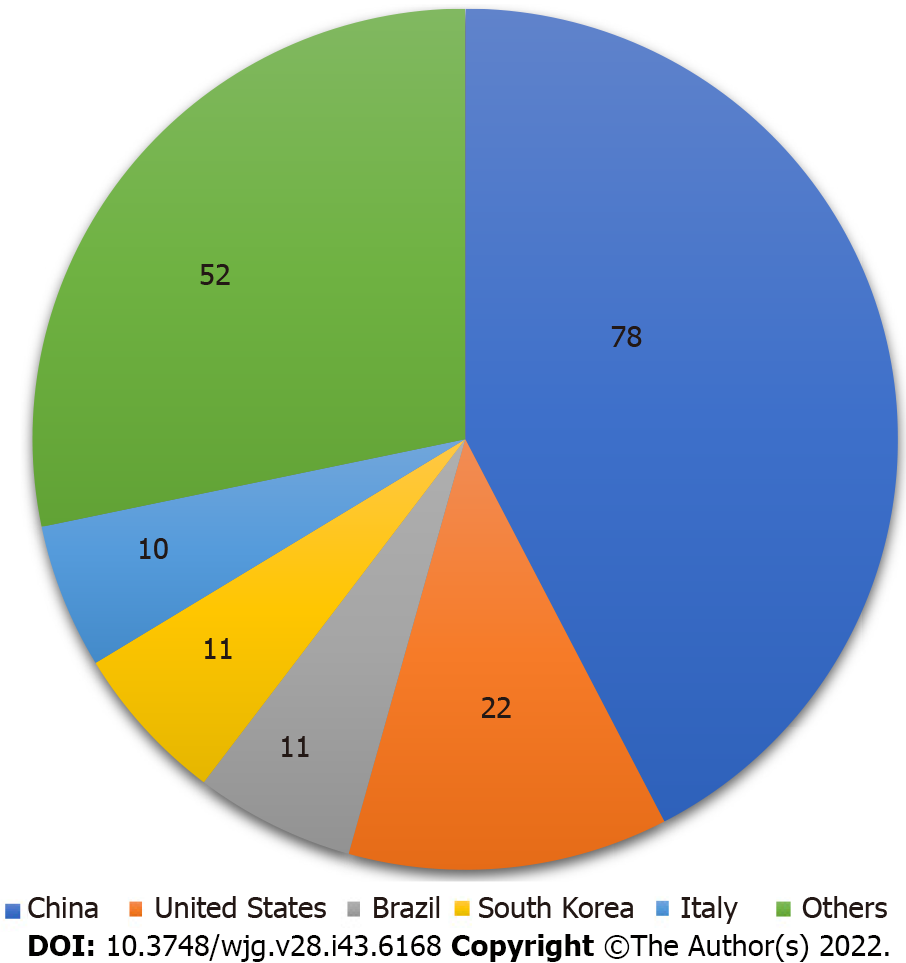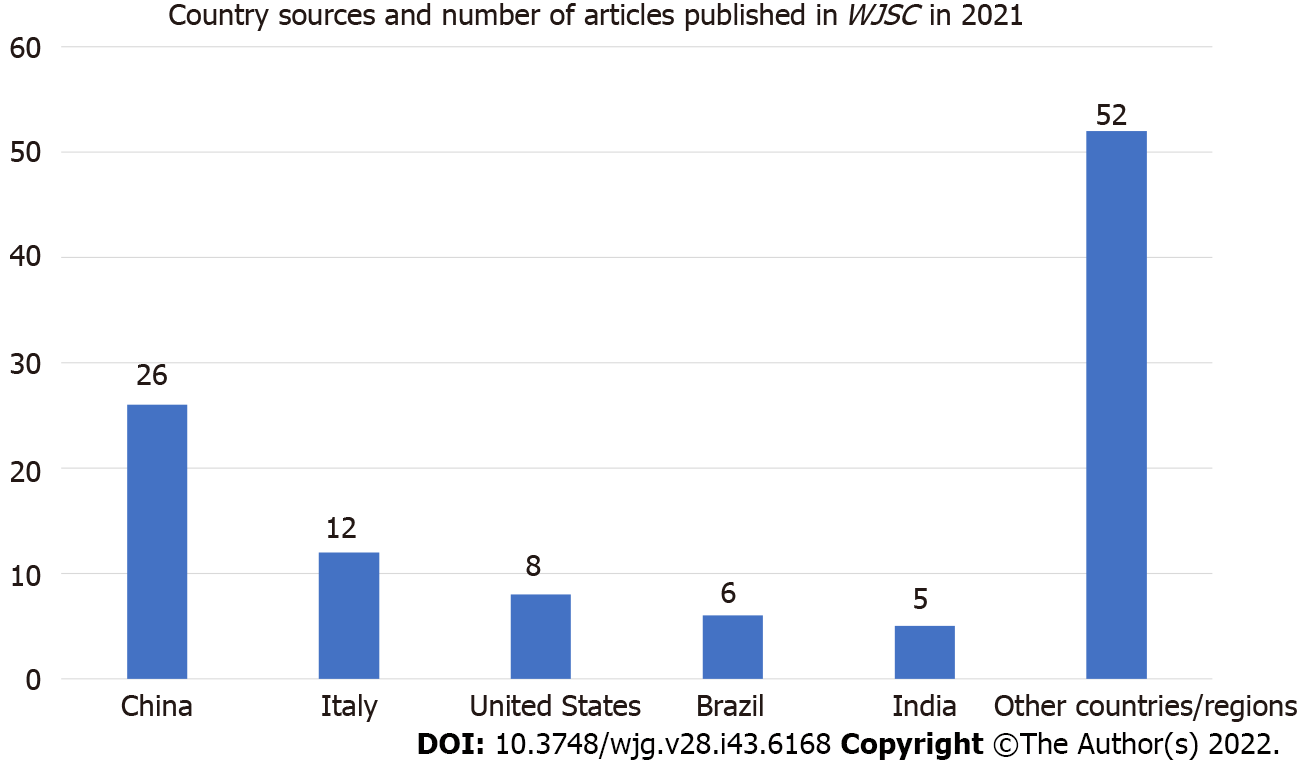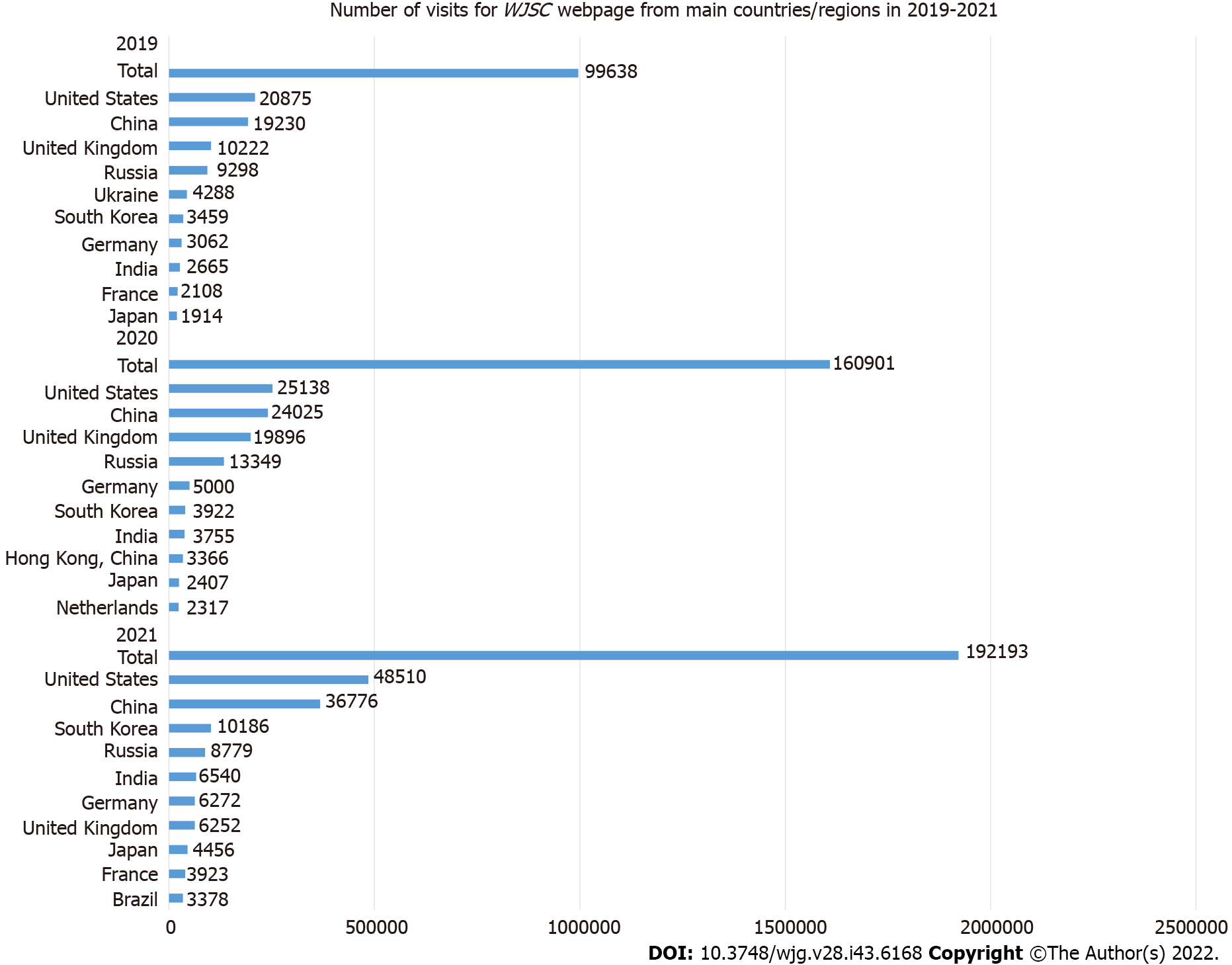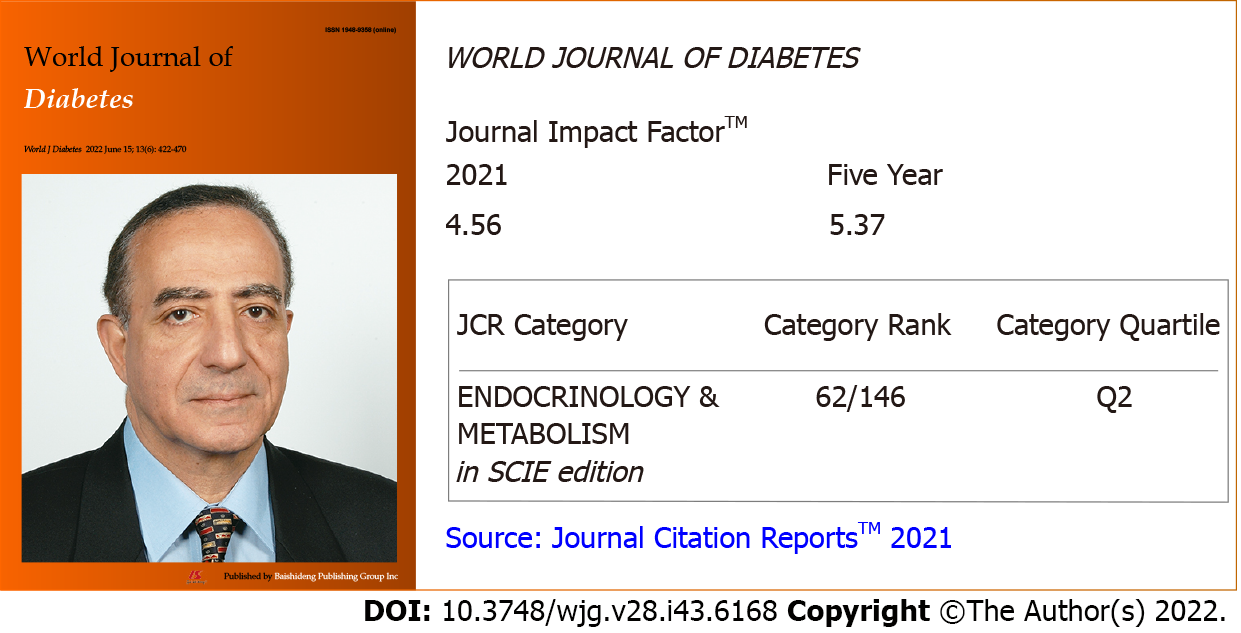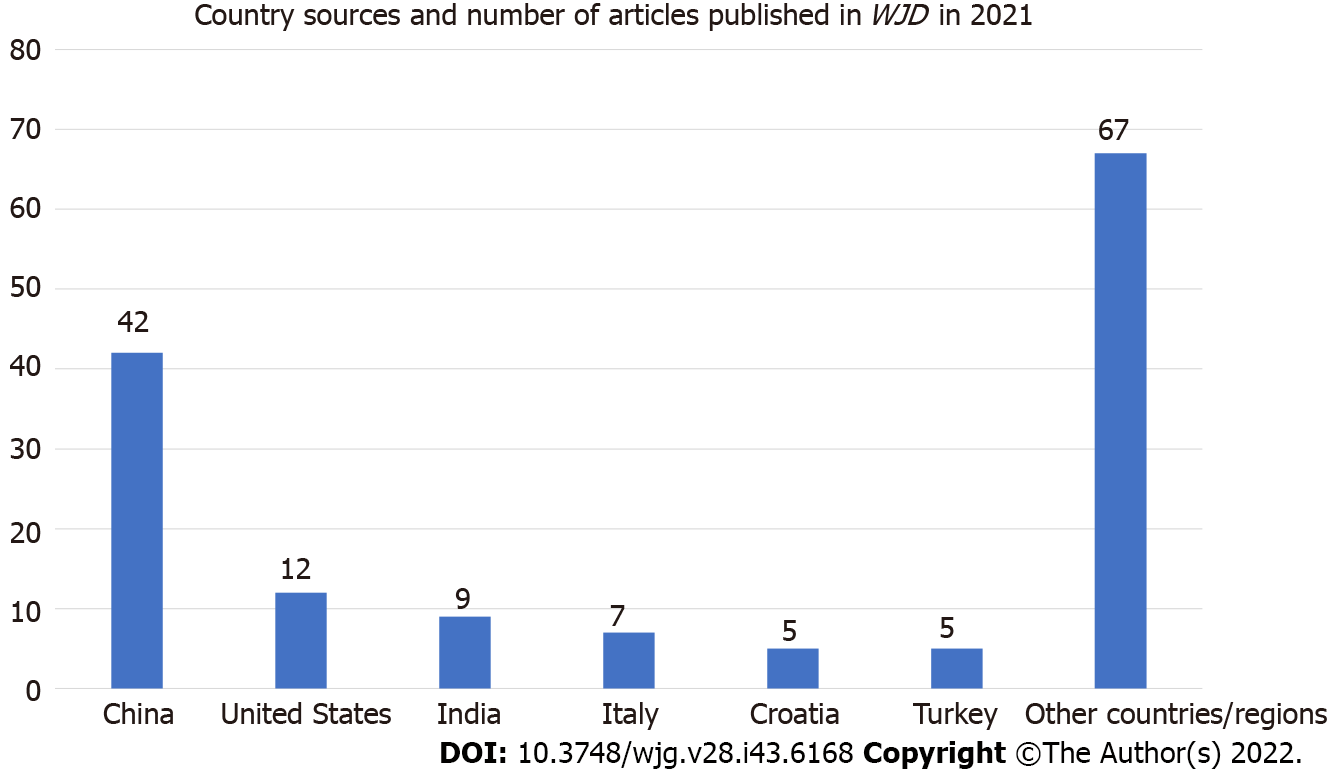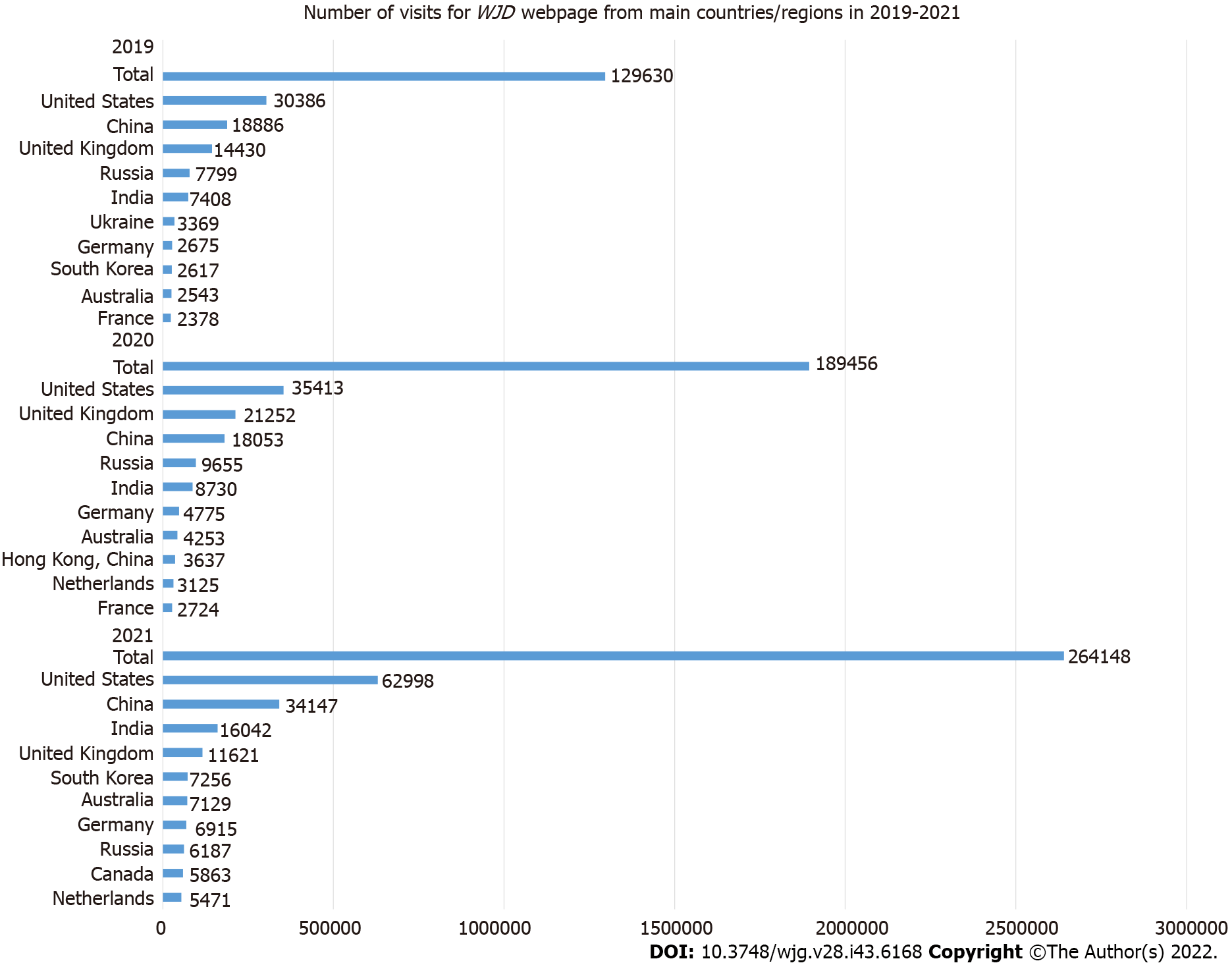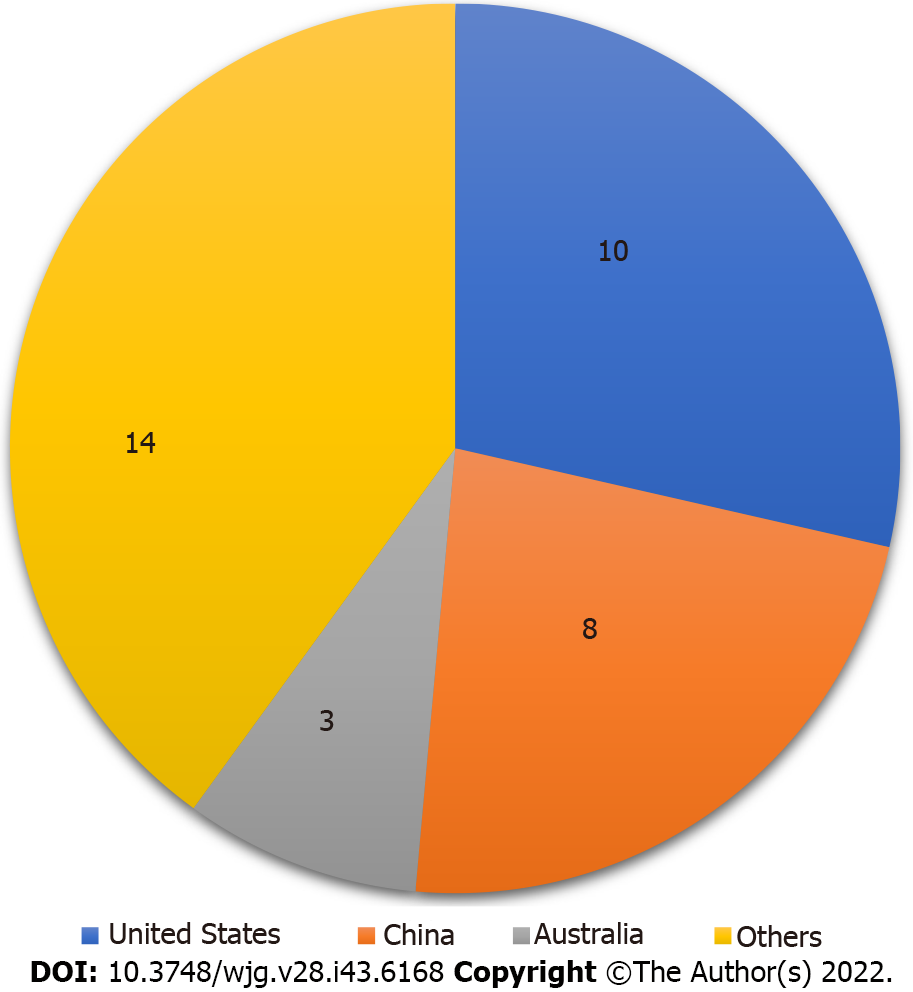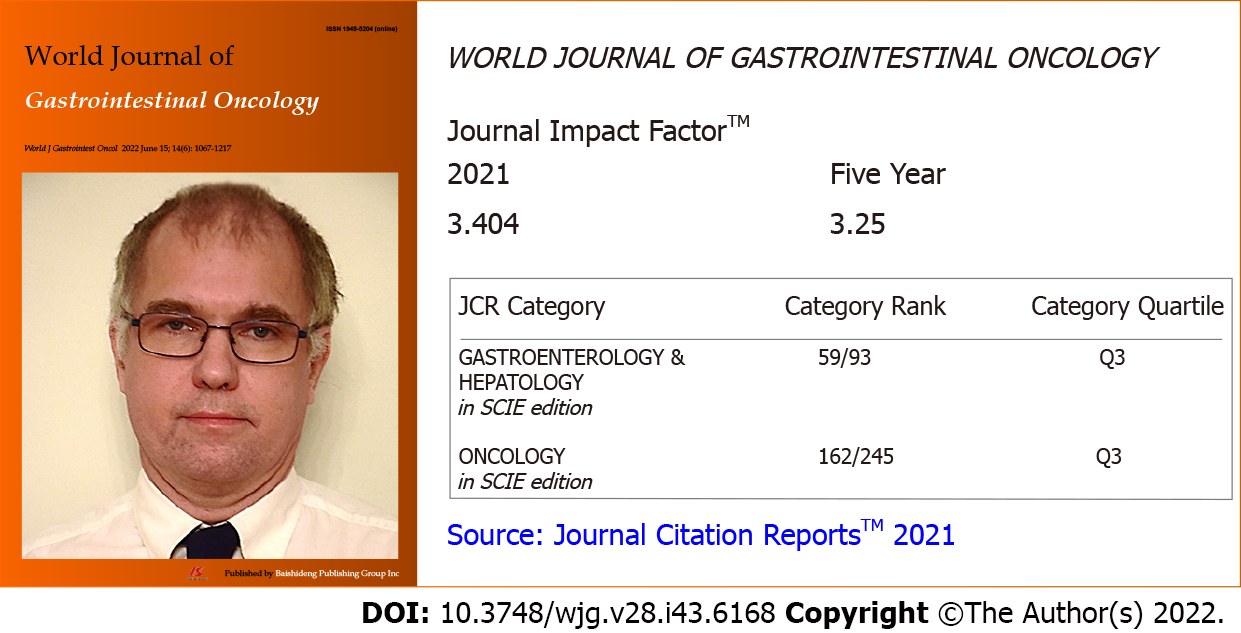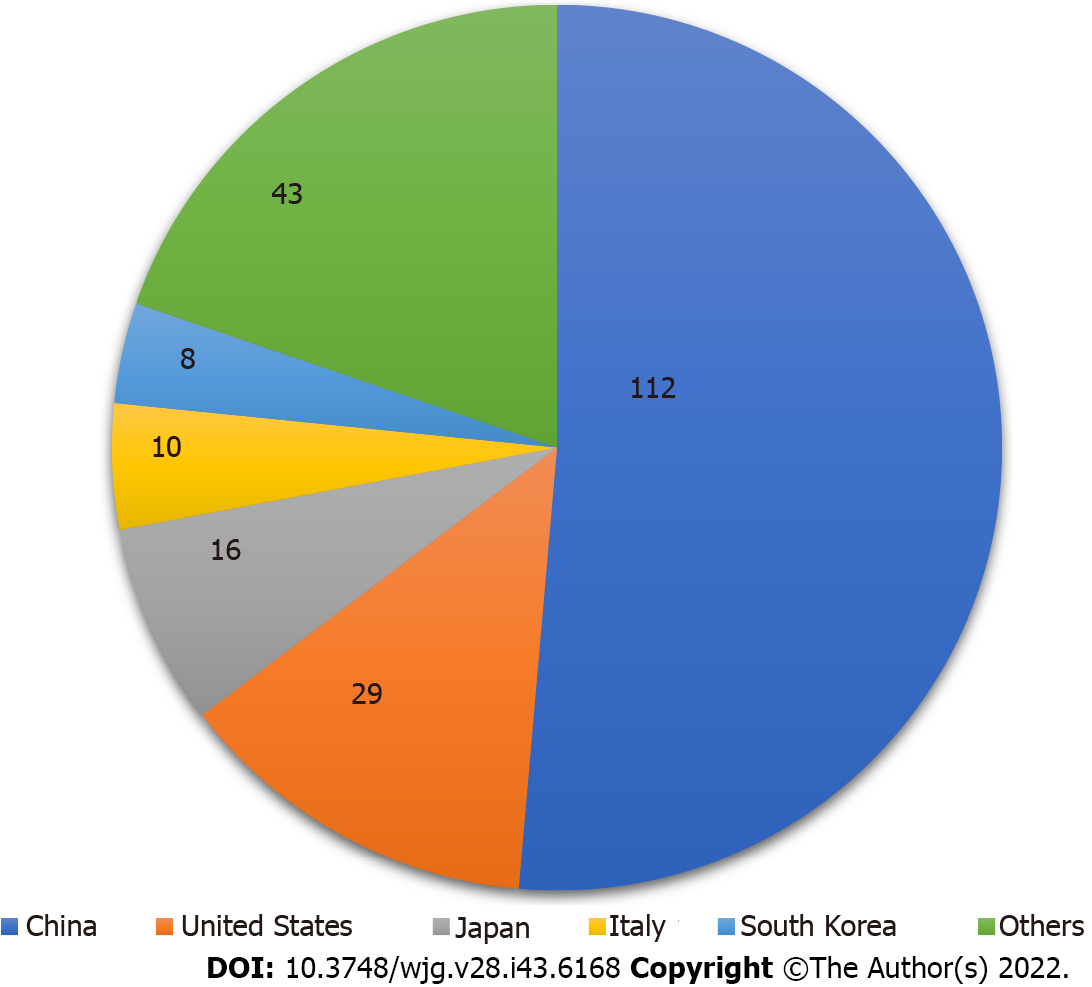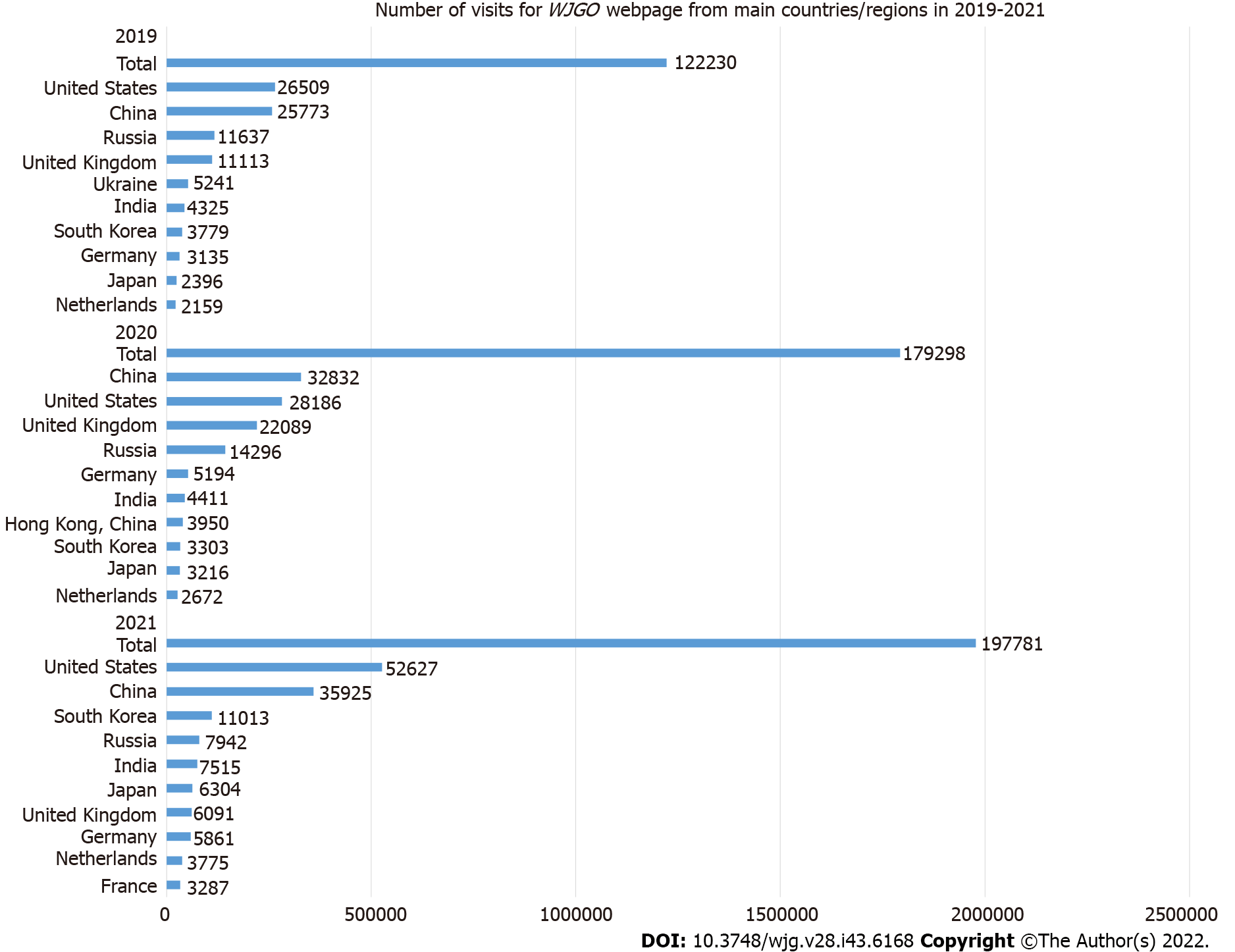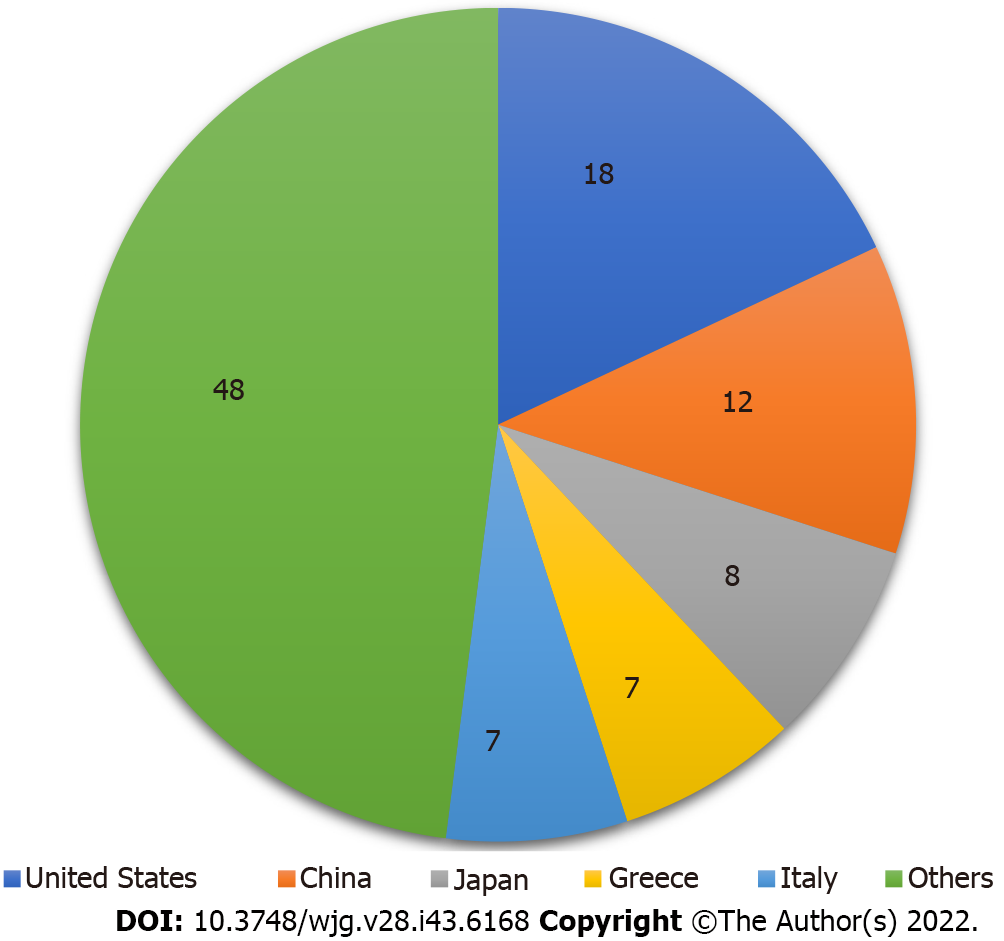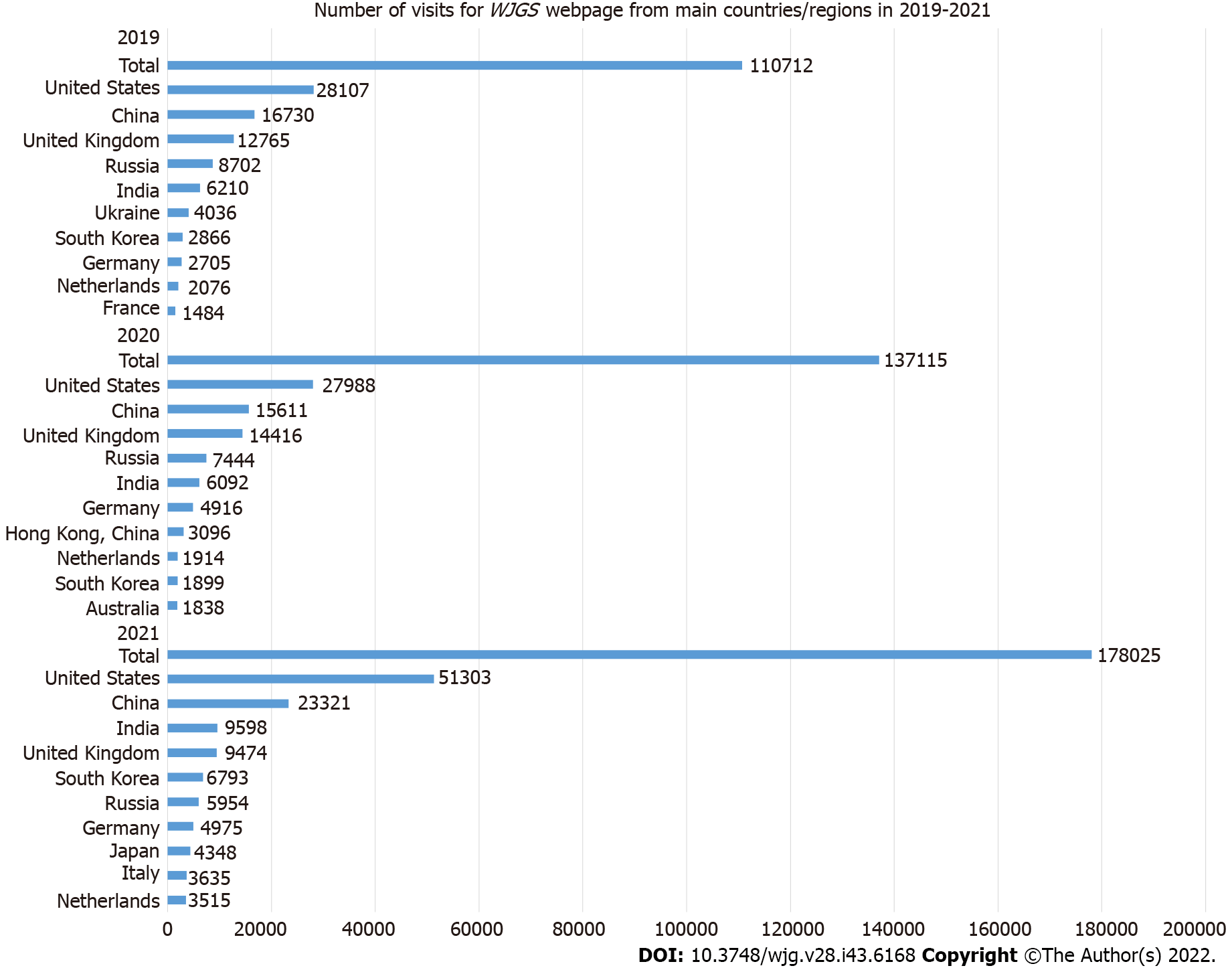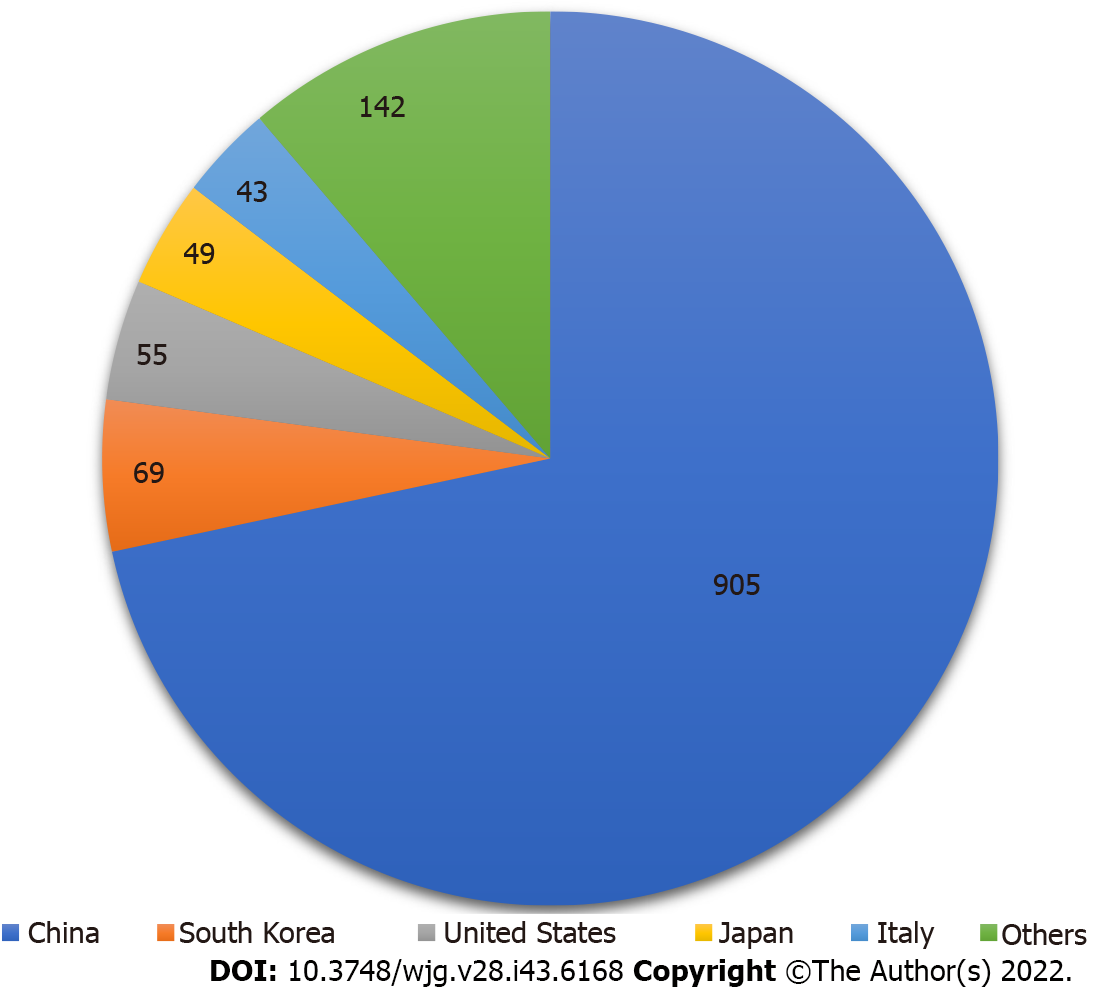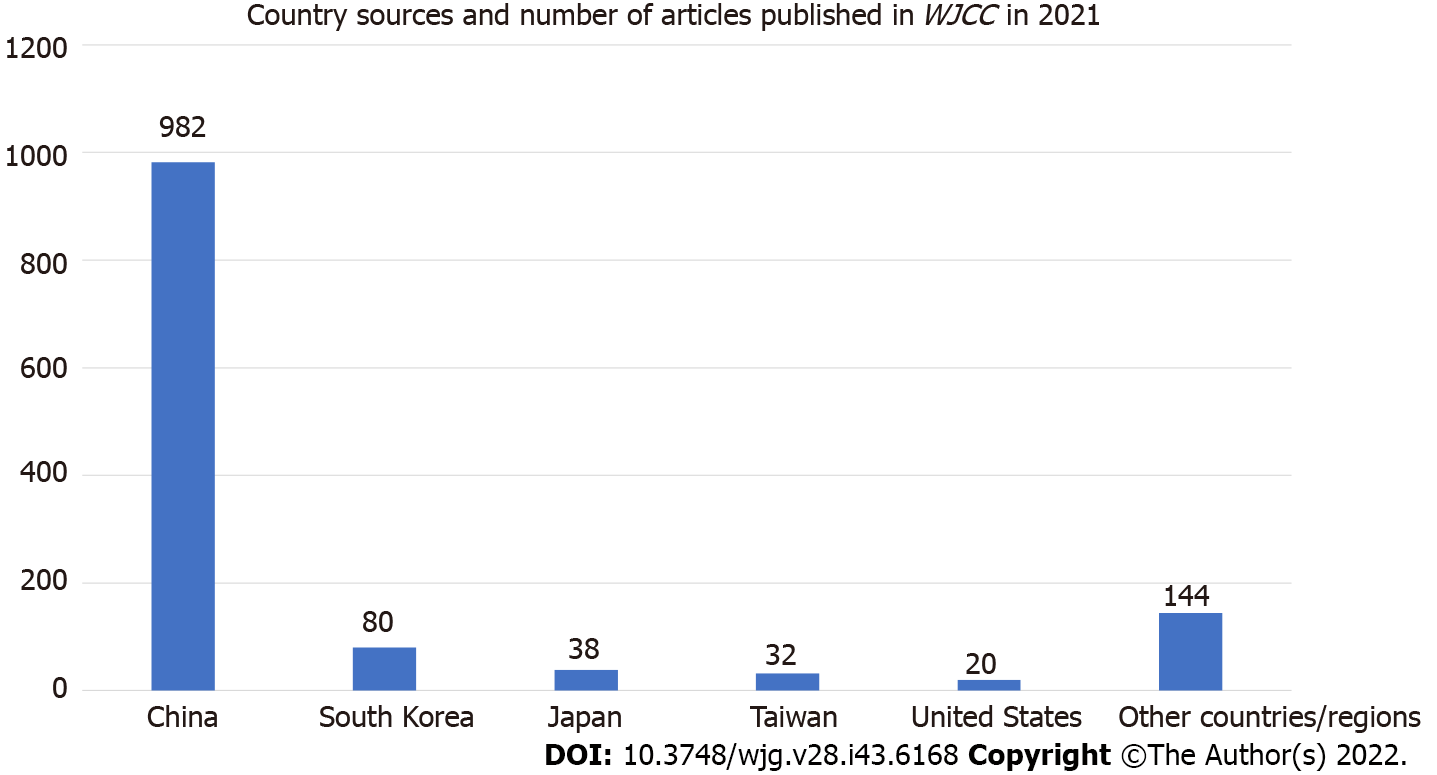Published online Nov 21, 2022. doi: 10.3748/wjg.v28.i43.6168
Peer-review started: October 8, 2022
First decision: October 20, 2022
Revised: October 27, 2022
Accepted: November 10, 2022
Article in press: November 10, 2022
Published online: November 21, 2022
Processing time: 39 Days and 10.7 Hours
Journal Impact Factor™ (JIF) is often used to evaluate the relative reputation and quality of academic journals in their respective fields, and can greatly influence the quality and scope of subsequent manuscript submissions. Therefore, many if not all academic journals are interested in increasing their JIF, to improve their academic impact.
To determine the importance of the integrity of the editorial and publication process in improving the academic influence of academic journals and the JIF of academic journals.
In this paper, we describe our statistical analysis of bibliometric factors - including the 2021 JIFs released in the Journal Citation Report™ 2022, discipline rankings, received and published articles in 2019-2021, and webpage visits and downloads - for seven journals published by Baishideng Publishing Group (Baishideng) and indexed in Science Citation Index Expanded™; ultimately, we introduce and discuss the editing and publishing processes of Baishideng’s journals in their entirety, as they form the basis for our objective of safeguarding and bolstering integrity in academic publication.
For the seven journals assessed, their 2021 JIFs were basically unchanged from 2020, with the current metric ranging from 5.374 for World Journal of Gastroenterology (WJG) to 1.534 for World Journal of Clinical Cases (WJCC). Further assessments of the journals’ bibliometrics from 2019 to 2020, showed that World Journal of Stem Cells has the highest self-citation rate (1.43%) and World Journal of Gastrointestinal Surgery has the lowest (0.21%). Additionally, the total 3012 articles published during this period were cited by more than 20000 articles in approximately 8000 academic journals. Of note, the 1102 articles published in WJG were cited by articles in 3059 journals, among which 171 journals have a JIF of > 10, including internationally renowned academic journals such as CA-A Cancer Journal for Clinicians (2021 JIF 286.130, record count: 1), Lancet (2021 JIF 202.731, record count: 4), Nature Reviews Immunology (2021 JIF 108.555, record count: 2), Nature Reviews Gastroenterology & Hepatology (2021 JIF 73.082, record count: 9), Lancet Gastroenterology & Hepatology (2021 JIF 45.042, record count: 8), Gastroenterology (2021 JIF 33.883, record count: 19), and Gut (2021 JIF 31.793, record count: 21). This suggests that Baishideng’s journals have been widely recognized for their academic quality. In the Reference Citation Analysis (RCA) database, all seven Baishideng-published journals obtained a 2022 Journal Article Influence Index (JAII). For example, WJG has a 2022 JAII of 22.048, ranking 18th out of 102 journals in the field of gastroenterology & hepatology in the RCA, with 469909 total citations (6/102) and 21313 total articles (5/102). The numbers of manuscripts received and published in 2021 were both higher than those in 2019-2020. For example, WJCC received a total of 3650 manuscripts in 2021, which is 91.1% higher than those in 2019-2020 (average: 1910 papers/year). In 2021, WJCC published 1296 articles, representing an increase of 105.1% compared to those in 2019-2020 (average: 632 articles/year). The numbers of webpage visits and downloads received by the seven journals have increased year by year. For example, the number of total visits received by WJG in 2019-2021 was 1974052 in 2019, 2317835 in 2020 (increased by 17.4% compared with that in 2019), and 2652555 in 2021 (increased by 4.4% compared with that in 2020). The visitors were from more than 220 countries and regions worldwide, such as the United States, China, and the United Kingdom. Open access (OA) plays a vital role in improving the quality, efficiency, transparency, and integrity of academic journal publishing. From 2019 to 2021, a total of 5543 OA articles were published in the seven journals, of which 2083 (37.6%) were invited and published free-of-charge. During the same period, 1683 articles were published in WJG, and the authors were from more than 70 countries and regions. For the total 5543 articles published in the seven journals from 2019 to 2021, 3903 article quality tracking reports were received after the online publication of these articles. The quality of the articles was further evaluated through the Baishideng’s article quality and author evaluation tracking system, with 4655 articles (84.0%) having received author evaluation and feedback, which contributes to tracking metrics for authors’ satisfaction with the collective publication processes. From March 25, 2021 to June 28, 2022, the seven journals received a total of 424 reader evaluations and 229 letters from readers; this subsequent reader engagement demonstrates that the popularity of the published articles and the volume of their readership audience were improved through the reader evaluation system.
Ultimately, the findings from our bibliometric assessments indicate that establishing, promoting and actively practicing processes that safeguard and bolster the integrity of the editing and publication process also help to improve the academic influence of academic journals, which itself is the cornerstone for improving JIF.
Core Tip: This study describes a statistical analysis of bibliometric factors including the 2021 Journal Impact Factor™ (JIF) released in the Journal Citation Report™ 2022, discipline rankings, received and published articles in 2019-2021, and webpage visits and downloads for seven journals published by Baishideng Publishing Group (Baishideng). This study also introduces and discusses the editing and publishing processes of Baishideng’s journals in their entirety, as they form the basis for our objective of safeguarding and bolstering integrity in academic publication. The findings from these bibliometric assessments indicate that establishing, promoting, and actively practicing processes that safeguard and bolster the integrity of the editing and publication process also help to improve the academic influence of academic journals, which itself is the cornerstone for improving JIF.
- Citation: Wang JL, Li X, Fan JR, Yan JP, Gong ZM, Zhao Y, Wang DM, Ma L, Ma N, Guo DM, Ma LS. Integrity of the editing and publishing process is the basis for improving an academic journal’s Impact Factor. World J Gastroenterol 2022; 28(43): 6168-6202
- URL: https://www.wjgnet.com/1007-9327/full/v28/i43/6168.htm
- DOI: https://dx.doi.org/10.3748/wjg.v28.i43.6168
In June 2022, Clarivate Analytics officially released its Journal Citation Report™ (JCR) 2022, and more than 12000 academic journals received their new Journal Impact Factor™ (JIF). The concept of JIF as a metric of a journal’s impact in a given field was first proposed by Eugene Garfield in 1955, and was calculated as follows for any given year: Number of that year’s citations divided by the source items published in that journal during the previous 2 years[1]. Since then, JIF has been frequently used as a quantitative representation of the relative reputation and quality of academic journals in their respective fields[2]. Although JIF may be misused, it has an undeniable impact on the quality and scope of manuscript submissions[3-5]. Many authors use JIF when selecting an academic journal to which they will submit their manuscript, and the higher the JIF of the academic journal, the better its scientific reputation[6]. As such, managers of academic journals have focused their efforts on developing processes that will increase the respective JIFs and thereby improve the academic influence of each journal.
There are many factors affecting the JIF of an academic journal, such as whether the journal is open access (OA) and whether the journal is specialized[7]; however, few studies have focused on the impact of the integrity of the editing and publishing process on the improvement of the JIF of academic journals. In this study, we examined the importance of the integrity of the editorial and publication process in improving the JIF of academic journals by introducing and discussing the complete editing and publishing process of journals published by Baishideng Publishing Group (Baishideng), and statistically analyzing their 2021 JIFs released in the JCR 2022, published articles in recent years, and webpage visits and downloads for Baishideng’s seven journals included in Science Citation Index Expanded (SCIE), a Web of Science™ Core Collection index.
The seven SCIE-indexed journals published by Baishideng are all single-blind peer reviewed and OA. All manuscripts received by Baishideng’s journals, both invited and freely submitted, are subjected to external peer review. The external peer review assesses the manuscripts for scientific quality, linguistic quality, and adherence to ethical standards and norms.
Baishideng established a broad and thorough academic journal editing and publishing process by focusing on the basic functions of academic journals, including: (1) Registration, to ensure the priority of authors’ academic thoughts; (2) Peer review, to ensure the quality of the paper and obtain peer recognition; (3) Communication, to promote the dissemination of scientific findings; and (4) Document storage, to archive publications for future reference and textual research. Through the F6Publishing system, independently developed by Baishideng, each manuscript progresses stepwise through the complete editing and publishing process, including submission review, peer review, first decision, second decision, final acceptance, online publication[8], post-publication tracking of the quality of published articles, authors’ evaluation of the publishing process, and readers’ evaluation of the article (Figure 1).
We selected the seven SCIE-indexed journals from among the 47 total OA journals published by Baishideng, and performed systematic quantitative and statistical analyses based upon their 2021 JIFs, discipline rankings, and received and published articles in 2019-2021, including the main source countries/regions and the number of published articles. Furthermore, data were obtained from Web of Science, and the journals/articles citing the articles published in the respective seven Baishideng journals from 2019 to 2020 were statistically analyzed. In addition, we statistically analyzed the number of visits and downloads received by the seven journals’ respective webpages, the number of non-conforming submissions identified in the submission preview, the number of peer reviewers and editorial board members who participated in the manuscript peer review, and the number of manuscripts that needed language polishing at the second decision, as well as the number of evaluations received via the Baishideng article quality tracking system, author evaluation system, and reader evaluation system from 2019 to 2021.
In the JCR 2022, all seven of Baishideng’s SCIE-indexed journals received their latest JIF. Compared with the JIFs of the seven journals received in 2020, the 2021 JIFs of three journals increased, and those of the remaining four slightly decreased, yielding an overall similarity between the 2 years (Table 1).
| Journal title | 2021 JIF | 2020 JIF | 5-yr JIF | Category: Journal rank/total journals (quartile) |
| World Journal of Gastroenterology | 5.374 | 5.742 | 5.715 | Gastroenterology and Hepatology: 31/93 (Q2) |
| World Journal of Stem Cells | 5.247 | 5.326 | 4.964 | Cell and Tissue Engineering: 12/29 (Q2); Cell Biology: 86/194 (Q2) |
| World Journal of Diabetes | 4.560 | 3.763 | 5.370 | Endocrinology and Metabolism: 62/146 (Q2) |
| World Journal of Psychiatry | 3.500 | 4.571 | 7.380 | Psychiatry: 89/155 (Q3) |
| World Journal of Gastrointestinal Oncology | 3.404 | 3.393 | 3.250 | Oncology: 163/245 (Q3); Gastroenterology and Hepatology: 59/93 (Q3) |
| World Journal of Gastrointestinal Surgery | 2.505 | 2.582 | 3.099 | Surgery: 104/211 (Q2); Gastroenterology and Hepatology: 81/93 (Q4) |
| World Journal of Clinical Cases | 1.534 | 1.337 | 1.599 | Medicine, General and Internal: 135/172 (Q4) |
The 2021 JIF, number of received and published articles, and citations for World Journal of Gastroenterology in 2019-2021: According to the JCR 2022, the 2021 JIF of World Journal of Gastroenterology (WJG) is 5.374, and the 5-year JIF is 5.715, ranking 31st among 93 journals in the field of gastroenterology and hepatology, located in quartile (Q) 2 (Figure 2). The 2021 JIF of WJG decreased by 0.368 from its 2020 JIF (5.742).
According to the Reference Citation Analysis (RCA) database, independently developed by Baishideng, WJG has a 2022 Journal Article Influence Index [2022 JAII, calculated as (Total Citations/Total Articles)] of 22.048, ranking 18th out of 102 journals in the field of gastroenterology & hepatology in the RCA, with 469909 total citations (6/102) and 21313 total articles (5/102).
From 2019 to 2020, WJG received a total of 3986 articles (average: 1993 articles/year), among which 1247 (31.3%) were invited and 2739 (68.7%) were freely submitted; the acceptance rate was 27.6%. During that same period, WJG published 1102 articles (average: 551 articles/year), among which 479 (43.5%) were invited and 623 (56.5%) were freely submitted. As of July 26, 2022, the articles published in WJG received a total of 12458 citations (without self-citations: 12341) by 11413 articles (without self-citations: 11314), yielding a self-citation rate of 0.94%; there were a total of 6387 citations in 2021. After excluding self-citations, the 11314 articles that cited the WJG-published articles were from 3059 journals (data from Web of Science, Table 2); among these journals, 171 (5.6%) had a JIF of > 10 (data from Web of Science), accounting for 25.9% of the 660 total journals that had received a JIF of > 10 in the JCR 2022. Moreover, the journals citing the WJG-published articles include internationally renowned academic journals such as CA-A Cancer Journal for Clinicians (2021 JIF 286.130, record count: 1), Lancet (2021 JIF 202.731, record count: 4), and Nature Reviews Immunology (2021 JIF 108.555, record count: 2), and renowned academic journals in the field of gastroenterology & hepatology such as Nature Reviews Gastroenterology & Hepatology (2021 JIF 73.082, record count: 9), Lancet Gastroenterology & Hepatology (2021 JIF 45.042, record count: 8), Gastroenterology (2021 JIF 33.883, record count: 19), and Gut (2021 JIF 31.793, record count: 21). From 2019 to 2020, the authors of the 1102 articles published in WJG were from 71 countries/regions, represented by 472 articles (42.8%) from China, 165 (15.0%) from the United States, 93 (8.4%) from Italy, 82 (7.4%) from Japan, 51 (4.6%) from South Korea, and 239 (21.7%) from other countries/regions (data from Web of Science, Figure 3). Of note, the article entitled “Gastrointestinal and hepatic manifestations of COVID-19: A comprehensive review”, which was contributed by Cha et al[9] from Cleveland Clinic in the United States in 2020, is the article with the highest number of citations among the articles published in WJG. This article mainly reviews the gastrointestinal and hepatic manifestations of coronavirus disease 2019 (COVID-19). As of June 28, 2022, this article has been cited 77 times.
| Rank | Publication title | Record count |
| 1 | Cancers | 241 (2.13) |
| 2 | International Journal of Molecular Sciences | 241 (2.13) |
| 3 | Frontiers in Oncology | 193 (1.706) |
| 4 | Journal of Clinical Medicine | 138 (1.22) |
| 5 | Nutrients | 119 (1.052) |
| 6 | Scientific Reports | 111 (0.981) |
| 7 | Frontiers in Pharmacology | 100 (0.884) |
| 8 | Frontiers in Immunology | 92 (0.813) |
| 9 | Frontiers in Medicine | 89 (0.787) |
| 10 | World Journal of Clinical Cases | 77 (0.681) |
| 11 | Cells | 76 (0.672) |
| 12 | Digestive Diseases and Sciences | 73 (0.645) |
| 13 | Medicine | 71 (0.628) |
| 14 | Medicine Hagerstown | 70 (0.619) |
| 15 | Cureus | 67 (0.592) |
| 16 | Surgical Endoscopy | 67 (0.592) |
| 17 | Surgical Endoscopy and Other Interventional Techniques | 67 (0.592) |
| 18 | Diagnostics | 64 (0.566) |
| 19 | Diagnostics Basel Switzerland | 64 (0.566) |
| 20 | BMC Gastroenterology | 63 (0.557) |
| 21 | Biomed Research International | 55 (0.486) |
| 22 | Evidence Based Complementary and Alternative Medicine | 55 (0.486) |
| 23 | Evidence Based Complementary and Alternative Medicine ECAM | 55 (0.486) |
| 24 | PLOS One | 53 (0.468) |
| 25 | Other journals, n = 3025 | 9013 (79.662) |
In 2021, WJG received a total of 2109 manuscripts, of which 1116 (52.9%) were invited and 993 (47.1%) were freely submitted; the acceptance rate was 27.5%, which was 5.8% higher than that in 2019-2020 (average: 1993/year). A total of 581 articles were published in WJG in 2021, including 360 (62.0%) invited and 221 (38.0%) freely submitted. As of June 28, 2022, the number of total citations was 1039. The number of articles published in WJG in 2021 was 5.4% higher than that in 2019-2020 (551 articles/year on average). The authors were from 56 countries/regions, represented by 160 articles (27.5%) from China, 59 (10.2%) from Italy, 53 (9.1%) from the United States, 38 (6.5%) from Japan, 20 (3.4%) from South Korea, 20 (3.4%) from Brazil, and 231 (39.7%) from other countries/regions (Figure 4).
Number of webpage visits and downloads received by WJG in 2019-2021: From 2019 to 2021, the WJG webpage received a total of 1974052 visits in 2019, 2317835 in 2020 (an increase of 17.4% compared with that in 2019), and 2652555 in 2021 (an increase of 14.4% compared with that in 2020), with visits from more than 220 countries and regions worldwide (Figure 5). The number of downloads was 1117432 in 2019, 2459893 in 2020 (an increase of 120.1% compared with that in 2019), and 3754483 in 2021 (an increase of 52.6% compared with that in 2020), with downloads from more than 200 countries and regions worldwide.
The 2021 JIF, number of received and published articles, and citations for World Journal of Stem Cells in 2019-2021: According to the JCR 2022, the 2021 JIF of World Journal of Stem Cells (WJSC) is 5.247, and the 5-year JIF is 4.964, ranking 12th among 29 journals in the field of cell & tissue engineering, located in Q2 (Figure 6), and ranking 86th among 194 journals in the field of cell biology. The 2021 JIF of WJSC decreased by 0.079 from its 2020 JIF (5.326).
According to the RCA database, WJSC has a 2022 JAII of 17.729, ranking 13th out of 32 journals in the field of cell & tissue engineering in the RCA, with 12056 total citations (18/32) and 680 total articles (20/32).
From 2019 to 2020, WJSC received a total of 396 articles (average: 198 articles/year), among which 282 (71.2%) were invited and 114 (28.8%) were freely submitted; the acceptance rate was 46.5%. During the same period, WJSC published 184 articles (average: 92 articles/year), among which 155 (84.2%) were invited and 29 (15.8%) were freely submitted. As of June 28, 2022, the articles published in WJSC received a total of 1956 citations (without self-citations: 1928) by 1813 articles (without self-citations: 1794), yielding a self-citation rate of 1.43%; there were a total of 1000 citations in 2021. After excluding self-citations, the 1794 articles that cited the WJSC-published articles were from 858 journals (data from Web of Science, Table 3); among these journals, 61 (7.1%) had a JIF of > 10 (data from Web of Science), accounting for 9.2% of the 660 total journals that had received a JIF of > 10 in the JCR 2022. Moreover, the journals citing the WJSC-published articles include renowned academic journals in the field of cell biology such as Nature Reviews Molecular Cell Biology (2021 JIF 113.915, record count: 1) and Trends in Cell Biology (2021 JIF 21.167, record count: 1). From 2019 to 2020, the authors of the 184 articles published in WJSC were from 41 countries/regions, represented by 78 articles (42.4%) from China, 22 (12.0%) from the United States, 11 (6.0%) from Brazil, 51 (6.0%) from South Korea, 10 (5.4%) from Italy, and 52 (28.3%) from other countries/regions (data from Web of Science, Figure 7). Of note, the article entitled “Mesenchymal stem cells from different sources and their derived exosomes: A pre-clinical perspective”, which was contributed by Associate Professor Álvarez-Viejo et al[10] from Hospital Universitario Central de Asturias, Spain in 2020, is the article with the highest number of citations among the articles published in WJSC. This article mainly reviews the research progress of different sources of mesenchymal stem cells and their derived apoplasts from a preclinical perspective. As of June 28, 2022, this article has been cited 29 times.
| Rank | Publication title | Record count |
| 1 | International Journal of Molecular Sciences | 139 (7.748) |
| 2 | Cells | 76 (4.236) |
| 3 | Frontiers in Cell and Developmental Biology | 70 (3.902) |
| 4 | Stem Cell Research Therapy | 69 (3.846) |
| 5 | Stem Cells International | 44 (2.453) |
| 6 | Cancers | 37 (2.062) |
| 7 | Stem Cell Reviews and Reports | 24 (1.338) |
| 8 | Frontiers in Immunology | 23 (1.282) |
| 9 | Frontiers in Bioengineering and Biotechnology | 22 (1.226) |
| 10 | Biomedicines | 18 (1.003) |
| 11 | Scientific Reports | 18 (1.003) |
| 12 | Pharmaceutics | 17 (0.948) |
| 13 | Frontiers in Pharmacology | 16 (0.892) |
| 14 | Current Stem Cell Research Therapy | 14 (0.780) |
| 15 | Frontiers in Oncology | 12 (0.669) |
| 16 | Biology | 10 (0.557) |
| 17 | Biology Basel | 10 (0.557) |
| 18 | Biomolecules | 10 (0.557) |
| 19 | Molecules | 10 (0.557) |
| 20 | Molecules Basel Switzerland | 10 (0.557) |
| 21 | Applied Sciences Basel | 8 (0.446) |
| 22 | Journal of Clinical Medicine | 8 (0.446) |
| 23 | Molecular Biology Reports | 8 (0.446) |
| 24 | Neural Regeneration Research | 8 (0.446) |
| 25 | Other journals, n = 834 | 1113 (62.040) |
In 2021, WJSC received a total of 215 manuscripts, of which 167 (77.7%) were invited and 48 (22.3%) were freely submitted; the acceptance rate was 50.7%, which was 8.6% higher than that in 2019-2020 (average: 198 articles/year). A total of 109 articles were published in WJSC in 2021, including 96 (88.1%) invited and 13 (11.9%) freely submitted. As of June 28, 2022, the number of total citations was 164. The number of articles published in WJSC in 2021 was 18.5% higher than that in 2019-2020 (92 articles/year on average). The authors were from 28 countries/regions, represented by 26 articles (23.9%) from China, 12 (11.0%) from Italy, 8 (7.3%) from the United States, 6 (5.5%) from Brazil, 5 (4.6%) from India, and 52 (47.7%) from other countries/regions (Figure 8).
Number of webpage visits and downloads received by WJSC in 2019-2021: From 2019 to 2021, the WJSC webpage received a total of 99638 visits in 2019, 160901 in 2020 (an increase of 61.5% compared with that in 2019), and 192193 in 2021 (an increase of 19.4% compared with that in 2020), with visits from more than 180 countries and regions worldwide (Figure 9). The number of downloads was 51642 in 2019, 111236 in 2020 (an increase of 115.3% compared with that in 2019), and 180164 in 2021 (an increase of 62.0% compared with that in 2020), with downloads from more than 120 countries and regions worldwide.
The 2021 JIF, number of received and published articles, and citations for World Journal of Diabetes in 2019-2021: According to the JCR 2022, the 2021 JIF of World Journal of Diabetes (WJD) is 4.560, and the 5-year JIF is 5.370, ranking 62nd among 146 journals in the field of endocrinology & metabolism, located in Q2 (Figure 10). The 2021 JIF of WJD increased by 0.797 from its 2020 JIF (3.763).
According to the RCA database, WJD has a 2022 JAII of 24.495, ranking 48th out of 149 journals in the field of endocrinology & metabolism in the RCA, with 20331 total citations (92/149) and 830 total articles (124/149).
From 2019 to 2020, WJD received a total of 294 articles (average: 147 articles/year), among which 150 (51.0%) were invited and 144 (49.0%) were freely submitted; the acceptance rate was 37.4%. During the same period, WJD published 110 articles (average: 55 articles/year), among which 68 (61.8%) were invited and 42 (38.2%) were freely submitted. As of June 28, 2022, the articles published in WJD received a total of 964 citations (without self-citations: 959) by 931 articles (without self-citations: 927), yielding a self-citation rate of 0.52%; there were a total of 482 citations in 2021. After excluding self-citations, the 927 articles that cited the WJD-published articles were from 669 journals (data from Web of Science, Table 4); among these journals, 30 (4.5%) had a JIF of > 10 (data from Web of Science), accounting for 4.5% of the 660 total journals that had received a JIF of > 10 in the JCR 2022. Moreover, the journals citing the WJD-published articles include renowned academic journals in the field of endocrinology & metabolism such as Diabetes Care (2021 JIF 17.152, record count: 3), Obesity Reviews (2021 JIF 10.867, record count: 2), and Diabetologia (2021 JIF 10.460, record count: 3).
| Rank | Publication title | Record count |
| 1 | International Journal of Molecular Sciences | 35 (3.776) |
| 2 | Frontiers in Endocrinology | 22 (2.373) |
| 3 | Nutrients | 17 (1.834) |
| 4 | International Journal of Environmental Research and Public Health | 15 (1.618) |
| 5 | Journal of Clinical Medicine | 15 (1.618) |
| 6 | Diabetes Metabolic Syndrome and Obesity Targets and Therapy | 14 (1.510) |
| 7 | Diabetes Metabolic Syndrome | 13 (1.402) |
| 8 | Diabetes Metabolic Syndrome Clinical Research Reviews | 13 (1.402) |
| 9 | Cureus | 9 (0.971) |
| 10 | Diabetes Therapy | 8 (0.863) |
| 11 | Diabetes Therapy Research Treatment and Education of Diabetes and Related Disorders | 8 (0.863) |
| 12 | Antioxidants | 7 (0.755) |
| 13 | Antioxidants Basel Switzerland | 7 (0.755) |
| 14 | BMJ Open Diabetes Research Care | 7 (0.755) |
| 15 | Diabetes Research and Clinical Practice | 7 (0.755) |
| 16 | Medicine | 7 (0.755) |
| 17 | Medicine Hagerstown | 7 (0.755) |
| 18 | Metabolites | 7 (0.755) |
| 19 | PLOS One | 7 (0.755) |
| 20 | Scientific Reports | 7 (0.755) |
| 21 | Biomedicines | 6 (0.647) |
| 22 | Cardiovascular Diabetology | 6 (0.647) |
| 23 | Diabetes Obesity Metabolism | 6 (0.647) |
| 24 | Frontiers in Pharmacology | 6 (0.647) |
| 25 | Other journals, n = 645 | 671 (72.384) |
From 2019 to 2020, the authors of the 110 articles published in WJD were from 42 countries/regions, represented by 23 articles (20.9%) from the United States, 18 (16.4%) from China, 8 (7.3%) from India, 6 (5.5%) from Greece, 5 (4.5%) from Turkey, and 50 (45.5%) from other countries/regions (data from Web of Science, Figure 11). Of note, the article entitled “Evaluation of oxidative stress levels in obesity and diabetes by the free oxygen radical test and free oxygen radical defense assays and correlations with anthropometric and laboratory parameters”, which was contributed by Dr. Găman et al[11] from “Carol Davila” University of Medicine and Pharmacy, Romania in 2020, is the article with the highest number of citations among the articles published in WJD. This article focuses on the assessment of oxidative stress in obese and diabetic subjects and the possible correlation between oxidative stress and anthropometric and biochemical parameters. As of June 28, 2022, this article has been cited 39 times.
In 2021, WJD received a total of 300 manuscripts, of which 211 (70.3%) were invited and 89 (29.7%) were freely submitted; the acceptance rate was 49.0%, which was 104.1% higher than that in 2019-2020 (average: 147 articles/year). A total of 147 articles were published in WJD in 2021, including 111 (75.5%) invited and 36 (24.5%) freely submitted. As of June 28, 2022, the number of total citations was 286. The number of articles published in WJD in 2021 was 167.2% higher than that in 2019-2020 (55 articles/year on average). The authors were from 38 countries/regions, represented by 42 articles (28.6%) from China, 12 (8.2%) from the United States, 9 (6.1%) from India, 7 (4.8%) from Italy, 5 (3.4%) from Croatia, 5 (3.4%) from Turkey, and 67 (45.6%) from other countries/regions (Figure 12).
Number of webpage visits and downloads received by World Journal of Diabetes in 2019-2021: From 2019 to 2021, WJD website received a total of 129630 visits in 2019, 189456 in 2020 (an increase of 46.2% compared with that in 2019), and 264148 in 2021 (an increase of 39.4% compared with that in 2020), with visits from more than 200 countries and regions worldwide (Figure 13). The number of downloads was 76163 in 2019, 137218 in 2020 (an increase of 80.2% compared with that in 2019), and 239021 in 2021 (an increase of 74.2% compared with that in 2020), with downloads from more than 170 countries and regions worldwide.
The 2021 JIF, number of received and published articles, and citations for World Journal of Psychiatry in 2019-2021: According to the JCR 2022, the 2021 JIF of World Journal of Psychiatry (WJP) is 3.500, and the 5-year JIF is 7.380, ranking 89th among 155 journals in the field of psychiatry, located in Q3 (Figure 14). The 2021 JIF of WJP decreased by 1.071 from its 2020 JIF (4.571).
According to the RCA database, WJP has a 2022 JAII of 15.402, ranking 93rd out of 222 journals in the field of psychiatry in the RCA, with 6238 total citations (165/222) and 405 total articles (193/222).
From 2019 to 2020, WJP received a total of 112 articles (average: 56 articles/year), among which 60 (53.6%) were invited and 52 (46.4%) were freely submitted; the acceptance rate was 31.3%. During the same period, WJP published 35 articles (average: 18 articles/year), among which 25 (71.4%) were invited and 10 (28.6%) were freely submitted. As of June 28, 2022, the articles published in WJP received a total of 219 citations (without self-citations: 217) by 214 articles (without self-citations: 212), yielding a self-citation rate of 0.91%; there were a total of 121 citations in 2021. After excluding self-citations, the 212 articles that cited the WJP-published articles were from 76 journals (data from Web of Science, Table 5); among these journals, 9 (11.8%) had a JIF of > 10 (data from Web of Science), accounting for 1.4% of the 660 total journals that had received a JIF of > 10 in the JCR 2022. Moreover, the journals citing the WJP-published articles include renowned academic journals in the field of psychiatry such as World Psychiatry (2021 JIF 79.683, record count: 1), Asian Journal of Psychiatry (2021 JIF 13.890, record count: 2), and Molecular Psychiatry (2021 JIF 13.437, record count: 1).
| Rank | Publication title | Record count |
| 1 | Frontiers in Psychiatry | 9 (4.245) |
| 2 | Journal of Affective Disorders | 7 (3.302) |
| 3 | Australian & New Zealand Journal of Psychiatry | 6 (1.415) |
| 4 | BMC Psychiatry | 6 (2.830) |
| 5 | International Journal of Environmental Research and Public Health | 6 (2.830) |
| 6 | International Journal of Advanced Computer Science and Applications | 5 (2.358) |
| 7 | European Psychiatry | 4 (1.887) |
| 8 | Brain and Behavior | 3 (1.415) |
| 9 | Journal of Clinical Medicine | 3 (1.415) |
| 10 | Journal of Personalized Medicine | 3 (1.415) |
| 11 | Psychiatria Danubina | 3 (1.415) |
| 12 | Advances in Medical Education and Practice | 2 (0.943) |
| 13 | Asian Journal of Psychiatry | 2 (0.943) |
| 14 | Brain Sciences | 2 (0.943) |
| 15 | Clinical Neuropsychiatry | 2 (0.943) |
| 16 | European Archives of Psychiatry and Clinical Neuroscience | 2 (0.943) |
| 17 | European Neuropsychopharmacology | 2 (0.943) |
| 18 | Frontiers in Neuroscience | 2 (0.943) |
| 19 | Frontiers in Psychology | 2 (0.943) |
| 20 | Indian Journal of Psychiatry | 2 (0.943) |
| 21 | Indian Journal of Psychological Medicine | 2 (0.943) |
| 22 | Journal of Autism and Developmental Disorders | 2 (0.943) |
| 23 | Other journals, n = 54 | 135 (63.679) |
From 2019 to 2020, the authors of the 35 articles published in WJP were from 22 countries/regions, represented by 10 articles (28.6%) from the United States, 8 (22.9%) from China, 3 (8.6%) from Australia, and 14 (40.0%) from other countries/regions (data from Web of Science, Figure 15). Of note, the article entitled “How to construct neuroscience-informed psychiatric classification? Towards nomothetic networks psychiatry”, which was contributed by Professor Stoyanov and Maes et al[12] from Medical University of Plovdiv, Bulgaria in 2020, is the article with the highest number of citations among the articles published in WJP. This article mainly reviews how to construct neuroscience-informed psychiatric classification from the perspective of nomothetic networks psychiatry. As of June 28, 2022, this article has been cited 19 times.
In 2021, WJP received a total of 265 manuscripts, of which 222 (83.8%) were invited and 43 (16.2%) were freely submitted; the acceptance rate was 38.9%, which was 373.2% higher than that in 2019-2020 (average: 56/year). A total of 103 articles were published in WJP in 2021, including 93 (90.3%) invited and 10 (9.7%) freely submitted. As of June 28, 2022, the number of total citations was 146. The number of articles published in WJP in 2021 was 472.2% higher than that in 2019-2020 (18 articles/year on average). The authors were from 28 countries/regions, represented by 11 articles (10.7%) from China, 10 (9.7%) from Italy, 8 (7.8%) from the United States, 5 (4.9%) from Spain, 4 (3.9%) from Austria, 4 (3.9%) from Brazil, and 61 (59.2%) from other countries/regions (Figure 16).
Number of webpage visits and downloads received by WJP in 2019-2021: From 2019 to 2021, WJP received a total of 47123 visits in 2019, 82197 in 2020 (an increase of 74.4% compared with that in 2019), and 130151 in 2021 (an increase of 58.3% compared with that in 2020), with visits from more than 180 countries and regions worldwide (Figure 17). The number of downloads was 28838 in 2019, 59532 in 2020 (an increase of 106.4% compared with that in 2019), and 113939 in 2021 (an increase of 91.4% compared with that in 2020), with downloads from more than 130 countries and regions worldwide.
The 2021 JIF, number of received and published articles, and citations for World Journal of Gastrointestinal Oncology in 2019-2021: According to the JCR 2022, the 2021 JIF of World Journal of Gastrointestinal Oncology (WJGO) is 3.404, and the 5-year JIF is 3.250, ranking 162nd among 245 journals in the field of oncology, and ranking 59th among 93 journals in the field of cell biology, located in Q3 (Figure 18). The 2021 JIF of WJGO increased by 0.011 from its 2020 JIF (3.393).
According to the RCA database, WJGO has a 2022 JAII of 11.592, ranking 57th out of 102 journals in the field of gastroenterology & hepatology in the RCA, with 11627 total citations (63/102) and 1003 total articles (74/102).
From 2019 to 2020, WJGO received a total of 476 articles (average: 238 articles/year), among which 200 articles (42.0%) were invited and 276 (58.0%) were freely submitted; the acceptance rate was 45.8%. During the same period, WJGO published 218 articles (average: 109 articles/year), among which 81 (37.2%) were invited and 137 (62.8%) were freely submitted. As of June 28, 2022, the articles published in WJGO received a total of 1543 citations (without self-citations: 1533) by 1495 articles (without self-citations: 1486), yielding a self-citation rate of 0.65%; there were a total of 780 citations in 2021. After excluding self-citations, the 1486 articles that cited the WJGO-published articles were from 791 journals (data from Web of Science, Table 6); among these journals, 45 (5.7%) had a JIF of > 10 (data from Web of Science), accounting for 6.8% of the 660 total journals that had received a JIF of > 10 in the JCR 2022. Moreover, the journals citing the WJGO-published articles include renowned academic journals in the field of oncology such as CA-A Cancer Journal for Clinicians (2021 JIF 286.130, record count: 1), Nature Reviews Cancer (2021 JIF 69.800, record count: 1), and Nature Reviews Clinical Oncology (2021 JIF 65.011, record count: 1). From 2019 to 2020, the authors of the 218 articles published in WJGO were from 31 countries/regions, represented by 112 articles (51.4%) from China, 29 (13.3%) from the United States, 16 (7.3%) from Japan, 10 (4.6%) from Italy, 8 (3.7%) from South Korea, and 43 (19.7%) from other countries/regions (data from Web of Science, Figure 19). Of note, the article entitled “Pancreatic ductal adenocarcinoma: Treatment hurdles, tumor microenvironment and immunotherapy”, which was contributed by Sarantis et al[13] from National and Kapodistrian University of Athens, Greece in 2020, is the article with the highest number of citations among the articles published in WJGO. This article mainly reviews the latest research advances in the treatment barriers, tumor microenvironment, and immunotherapy for pancreatic ductal adenocarcinoma. As of June 28, 2022, this article has been cited 50 times.
| Rank | Publication title | Record count |
| 1 | Cancers | 70 (4.711) |
| 2 | Frontiers in Oncology | 64 (4.307) |
| 3 | International Journal of Molecular Sciences | 32 (2.153) |
| 4 | Cells | 21 (1.413) |
| 5 | BMC Cancer | 20 (1.346) |
| 6 | Cancer Management and Research | 17 (1.144) |
| 7 | Aging | 16 (1.077) |
| 8 | Aging US | 16 (1.077) |
| 9 | Biomedicines | 16 (1.077) |
| 10 | Scientific Reports | 16 (1.077) |
| 11 | Frontiers in Cell and Developmental Biology | 15 (1.009) |
| 12 | Journal of Clinical Medicine | 15 (1.009) |
| 13 | World Journal of Clinical Cases | 14 (0.942) |
| 14 | Biomed Research International | 13 (0.875) |
| 15 | European Review for Medical and Pharmacological Sciences | 13 (0.875) |
| 16 | World Journal of Gastroenterology | 13 (0.875) |
| 17 | Journal of Gastrointestinal Oncology | 12 (0.808) |
| 18 | Frontiers in Genetics | 11 (0.740) |
| 19 | Annals of Surgical Oncology | 10 (0.673) |
| 20 | Frontiers in Pharmacology | 10 (0.673) |
| 21 | Oncology Letters | 10 (0.673) |
| 22 | PLOS One | 10 (0.673) |
| 23 | Surgical Endoscopy | 10 (0.673) |
| 24 | Other journals, n = 768 | 1042 (70.121) |
In 2021, WJGO received a total of 424 manuscripts, of which 254 (59.9%) were invited and 170 (40.1%) were freely submitted; the acceptance rate was 37.0%, which was 78.2% higher than that in 2019-2020 (average: 238 articles/year). A total of 157 articles were published in WJGO in 2021, including 115 (73.2%) invited and 42 (26.8%) freely submitted. As of June 28, 2022, the number of total citations was 156. The number of articles published in WJGO in 2021 was 44.0% higher than that in 2019-2020 (109 articles/year on average). The authors were from 33 countries/regions, represented by 62 articles (39.5%) from China, 15 (9.6%) from Italy, 14 (8.9%) from the United States, 10 (6.4%) from Japan, 5 (3.2%) from South Korea, and 51 (32.5%) from other countries/regions (Figure 20).
Number of webpage visits and downloads received by WJGO in 2019-2021: From 2019 to 2021, the WJGO webpage received a total of 122230 visits in 2019, 179298 in 2020 (an increase of 46.7% compared with that in 2019), and 197781 in 2021 (an increase of 10.3% compared with that in 2020), with visits from more than 180 countries and regions worldwide (Figure 21). The number of downloads was 77505 in 2019, 165794 in 2020 (an increase of 113.9% compared with that in 2019), and 266672 in 2021 (an increase of 60.8% compared with that in 2020), with downloads from more than 130 countries and regions worldwide.
The 2021 JIF, number of received and published articles, and citations for World Journal of Gastrointestinal Surgery in 2019-2021: According to the JCR 2022, the 2021 JIF of World Journal of Gastrointestinal Surgery (WJGS) is 2.505, and the 5-year JIF is 3.099, ranking 104th among 211 journals in the field of surgery, located in Q2, and ranking 81st among 93 journals in the field of gastroenterology & hepatology, located in Q4 (Figure 22). The 2021 JIF of WJGS decreased by 0.077 from its 2020 JIF (2.582).
According to the RCA database, WJGS has a 2022 JAII of 10.615, ranking 62nd out of 102 journals in the field of gastroenterology & hepatology in the RCA, with 8694 total citations (71/102) and 819 total articles (80/102).
From 2019 to 2020, WJGS received a total of 297 articles (average: 149 articles/year), among which 113 (38.0%) were invited and 184 (62.0%) were freely submitted; the acceptance rate was 33.7%. During the same period, WJGS published 100 articles (average: 50 articles/year), among which 50 (50.0%) were invited and 50 (50.0%) were freely submitted. As of June 28, 2022, the articles published in WJGS received a total of 483 citations (without self-citations: 482) by 473 articles (without self-citations: 472), yielding a self-citation rate of 0.21%; there were a total of 242 citations in 2021. After excluding self-citations, the 472 articles that cited the WJGS-published articles were from 341 journals (data from Web of Science, Table 7); among these journals, 11 (3.2%) had a JIF of > 10 (data from Web of Science), accounting for 1.7% of the 660 total journals that had received a JIF of > 10 in the JCR 2022. Moreover, the journals citing the WJGS-published articles include renowned academic journals in the field of surgery such as JAMA Surgery (2021 JIF 16.681, record count: 1) and British Journal of Surgery (2021 JIF 11.122, record count: 1).
| Rank | Publication title | Record count |
| 1 | Frontiers in Oncology | 13 (2.754) |
| 2 | Surgical Endoscopy | 13 (2.754) |
| 3 | Surgical Endoscopy and Other Interventional Techniques | 13 (2.754) |
| 4 | Cancers | 12 (2.542) |
| 5 | Cureus | 11 (2.331) |
| 6 | HPB | 10 (2.119) |
| 7 | Journal of Gastrointestinal Surgery | 10 (2.119) |
| 8 | Langenbeck’s Archives of Surgery | 10 (2.119) |
| 9 | Journal of Clinical Medicine | 9 (1.907) |
| 10 | Diseases of the Esophagus | 8 (1.695) |
| 11 | Updates in Surgery | 8 (1.695) |
| 12 | World Journal of Clinical Cases | 7 (1.483) |
| 13 | BMJ Case Reports | 6 (1.271) |
| 14 | Frontiers in Surgery | 6 (1.271) |
| 15 | Annals of Coloproctology | 5 (1.059) |
| 16 | BMC Surgery | 5 (1.059) |
| 17 | Egyptian Journal of Surgery | 5 (1.059) |
| 18 | Indian Journal of Surgery | 5 (1.059) |
| 19 | Scientific Reports | 5 (1.059) |
| 20 | Annals of Coloproctology | 4 (0.847) |
| 21 | Cureus Journal of Medical Science | 4 (0.847) |
| 22 | Other journals, n = 320 | 303 (64.195) |
From 2019 to 2020, the authors of the 100 articles published in WJGS were from 31 countries/regions, represented by 18 articles (18.0%) from the United States, 12 (12.0%) from China, 8 (8.0%) from Japan, 7 (7.0%) from Greece, 7 (7.0%) from Italy, and 48 (48.0%) from other countries/regions (data from Web of Science, Figure 23). Of note, the article entitled “Carbohydrate antigen 19-9 - tumor marker: Past, present, and future”, which was contributed by Dr. Lee et al[14] from Nanyang Technological University, Singapore in 2020, is the article with the highest number of citations among the articles published in WJGS. This article mainly reviews the related research on the tumor marker carbohydrate antigen 19-9. As of June 28, 2022, this article has been cited 31 times.
In 2021, WJGS received a total of 274 manuscripts, of which 141 (51.5%) were invited and 133 (48.5%) were freely submitted; the acceptance rate was 50.4%, which was 83.9% higher than that in 2019-2020 (average: 149 articles/year). A total of 138 articles were published in WJGS in 2021, including 86 (62.3%) invited and 52 (37.7%) freely submitted. As of June 28, 2022, the number of total citations was 119. The number of articles published in WJGS in 2021 was 176.0% higher than that in 2019-2020 (50 articles/year on average). The authors were from 30 countries/regions, represented by 47 articles (34.1%) from China, 16 (11.6%) from Italy, 12 (8.7%) from Japan, 8 (5.8%) from the United States, 5 (3.6%) from Singapore, 5 (3.6%) from Turkey, and 45 (32.6%) from other countries/regions (Figure 24).
Number of webpage visits and downloads received by WJGS in 2019-2021: From 2019 to 2021, the WJGS webpage received a total of 110712 visits in 2019, 137115 in 2020 (an increase of 23.8% compared with that in 2019), and 178025 in 2021 (an increase of 29.8% compared with that in 2020), with visits from more than 190 countries and regions worldwide (Figure 25). The number of downloads was 60397 in 2019, 111880 in 2020 (an increase of 85.2% compared with that in 2019), and 188632 in 2021 (an increase of 68.6% compared with that in 2020), with downloads from more than 150 countries and regions worldwide.
The 2021 JIF, number of received and published articles, and citations for World Journal of Clinical Cases in 2019-2021: According to the JCR 2022, the 2021 JIF of World Journal of Clinical Cases (WJCC) is 1.534, and the 5-year JIF is 1.599, ranking 135th among 172 journals in the field of general & internal medicine, located in Q4 (Figure 26). The 2021 JIF of WJCC increased by 0.197 from its 2020 JIF (1.337).
According to the RCA database, WJCC has a 2022 JAII of 3.046, ranking 174th out of 177 journals in the field of general & internal medicine in the RCA, with 12852 total citations (91/177) and 4219 total articles (52/177).
From 2019 to 2020, WJCC received a total of 3820 articles (average: 1910 articles/year), among which 485 (38.0%) were invited and 3335 (62.0%) were freely submitted; the acceptance rate was 33.1%. During that same period, WJCC published 1263 articles (average: 632 articles/year), among which 228 (18.1%) were invited and 1035 (81.9%) were freely submitted. As of June 28, 2022, the articles published in WJCC received a total of 3966 citations (without self-citations: 3933) by 3842 articles (without self-citations: 3815), yielding a self-citation rate of 0.83%; there were a total of 2112 citations in 2021. After excluding self-citations, the 3815 articles that cited the WJCC-published articles were from 2298 journals (data from Web of Science, Table 8); among these journals, 92 (4.0%) had a JIF of > 10 (data from Web of Science), accounting for 13.9% of the 660 total journals that had received a JIF of > 10 in the JCR 2022. Moreover, the journals citing the WJCC-published articles include renowned academic journals in the field of general & internal medicine such as New England Journal of Medicine (2021 JIF 176.079, record count: 1), Annals of Internal Medicine (2021 JIF 51.598, record count: 1), and JAMA Internal Medicine (2021 JIF 44.409, record count: 2).
| Rank | Publication title | Record count |
| 1 | Cureus | 63 (1.651) |
| 2 | International Journal of Molecular Sciences | 54 (1.415) |
| 3 | Journal of Clinical Medicine | 44 (1.153) |
| 4 | Medicine | 39 (1.022) |
| 5 | Medicine Hagerstown | 39 (1.022) |
| 6 | Frontiers in Oncology | 36 (0.944) |
| 7 | Cancers | 31 (0.813) |
| 8 | World Journal of Gastroenterology | 30 (0.786) |
| 9 | Cureus Journal of Medical Science | 29 (0.760) |
| 10 | International Journal of Environmental Research and Public Health | 29 (0.760) |
| 11 | Scientific Reports | 29 (0.760) |
| 12 | BMJ Case Reports | 24 (0.629) |
| 13 | Diagnostics | 24 (0.629) |
| 14 | Diagnostics Basel Switzerland | 24 (0.629) |
| 15 | Nutrients | 23 (0.603) |
| 16 | PLOS One | 22 (0.577) |
| 17 | BMC Gastroenterology | 20 (0.524) |
| 18 | Frontiers in Medicine | 20 (0.524) |
| 19 | American Journal of Translational Research | 19 (0.498) |
| 20 | Abdominal Radiology | 18 (0.472) |
| 21 | Abdominal Radiology New York | 18 (0.472) |
| 22 | Biomedicines | 16 (0.419) |
| 23 | Cells | 16 (0.419) |
| 24 | Frontiers in Immunology | 16 (0.419) |
| 25 | Other journals, n = 2274 | 3132 (82.097) |
From 2019 to 2020, the authors of the 1263 articles published in WJCC were from 59 countries/ regions, represented by 905 articles (71.7%) from China, 69 (5.5%) from South Korea, 55 (4.4%) from the United States, 49 (3.9%) from Japan, 43 (3.4%) from Italy, and 142 (11.2%) from other countries/regions (data from Web of Science, Figure 27). Of note, the article entitled “Fear can be more harmful than the severe acute respiratory syndrome coronavirus 2 in controlling the corona virus disease 2019 epidemic”, which was contributed by Chief Physician Ren et al[15] from Beijing Aerospace General Hospital, China in 2020, is the article with the highest number of citations among the articles published in WJCC. This article mainly reviews the discrimination and prejudice caused by the fear of disease or misinformation after the outbreak of COVID-19. As of June 28, 2022, this article has been cited 146 times.
In 2021, WJCC received a total of 3650 manuscripts, of which 233 (6.4%) were invited and 3417 (93.6%) were freely submitted; the acceptance rate was 35.5%, which was 91.1% higher than that in 2019-2020 (average: 1910 articles/year). A total of 1296 articles were published in WJCC in 2021, including 136 (10.5%) invited and 1160 (89.5%) freely submitted. As of June 28, 2022, the number of total citations was 563. The number of articles published in WJCC in 2021 was 105.1% higher than that in 2019-2020 (632 articles/year on average). The authors were from 45 countries/regions, represented by 982 articles (75.8%) from China, 80 (6.2%) from South Korea, 38 (2.9%) from Japan, 32 (2.5%) from Taiwan, 20 (1.5%) from the United States, and 144 (11.1%) from other countries/regions (Figure 28).
Number of webpage visits and downloads received by WJCC in 2019-2021: From 2019 to 2021, the WJCC webpage received a total of 363959 visits in 2019, 712451 in 2020 (an increase of 95.8% compared with that in 2019), and 908002 in 2021 (an increase of 27.4% compared with that in 2020), with visits from more than 210 countries and regions worldwide (Figure 29). The number of downloads was 174808 in 2019, 442635 in 2020 (an increase of 153.2% compared with that in 2019), and 128.1% in 2021 (an increase of 52.6% compared with that in 2020), with downloads from more than 180 countries and regions worldwide.
From 2019 to 2021, a total of 16618 articles were submitted by the authors to Baishideng’s seven SCIE-indexed journals. After preview by the Baishideng editorial office, 856 manuscripts (5.2%) were found not to meet the requirements of Baishideng for receiving manuscripts, and the authors failed to modify and supplement the relevant documents within the prescribed time. As a result, these manuscripts failed to pass the submission preview and were not sent for peer review.
From 2019 to 2021, a total of 15762 manuscripts submitted to Baishideng’s seven SCIE-indexed journals passed manuscript preview, and a total of 463297 peer reviews were performed by invited peer reviewers or editorial board members. Among these individuals, 30866 (6.7%) completed the peer review successfully, 66836 (14.4%) rejected the invitation to conduct peer review, 17976 (3.9%) agreed to conduct the peer review but failed to submit the peer review report on time, and 347619 (75.0%) failed to respond to the invitation. The success rate of manuscript peer review was low. We found that some of the peer reviewers’ comments on the manuscript were only one-sentence in length, with no explanation for their suggestion of acceptance of the manuscript and no changes to the manuscript, and comments providing no guiding value in improving the quality of the manuscript (e.g., “This is an interesting study. Recommend an acceptance.”, “This manuscript is very well written.”, “I recommend reject the study.”, etc). Baishideng acknowledged all the peer reviewers and editorial board members who completed the manuscript peer review online, on the publisher’s home page. For more details, please visit: https://www.f6publishing.com/highlyinfluentialpeerreviewers.
From 2019 to 2021, a total of 5543 manuscripts were accepted and published online in Baishideng’s seven SCIE-indexed journals. The grammatical content of all manuscripts submitted by non-native English speakers was verified based on Baishideng’s manuscript language editing policy (https://www.wjgnet.com/bpg/gerinfo/240). Among them, 3406 (61.4%) were polished by Baishideng’s language editors.
All seven of Baishideng’s SCIE-indexed journals adopt the OA publishing model, that is, authors pay to publish and readers read for free. A total of 5543 articles were published in the seven journals from 2019 to 2021, all of which are OA articles with unlimited length, unlimited number of figures and tables, and unlimited number of references and citations, available for all readers to access and download online. Of these, 2083 (37.6%) articles were invited and published free of article processing charge (APC). At the same time, Baishideng has an APC discount policy, in which the APC will be reduced by 10% if the free contribution meets one of the following conditions: (1) Supported by a fund of national level or above; (2) Having a corresponding author who is a member of an association of national level or above; (3) Having a first author who is a young scholar under 45 years old; or (4) Having a corresponding author who is a member of the editorial board or who serves as a peer reviewer.
As of June 28, 2022, Baishideng has received 3903 quality-tracking evaluation reports from members of the Baishideng journal editorial boards for 5543 articles published in the seven journals from 2019 to 2021. The Baishideng editorial office verified and replied to every article tracking evaluation report received, and dealt with the important issues found and feedback by the editorial board members in a timely manner. Among them, 3765 reports (96.5%) gave positive comments or did not provide comments, 105 (2.7%) proposed revision opinions or pointed out article limitations, and 33 (0.8%) proposed editing and production quality problems. The Baishideng editorial office has asked the authors to clarify the problems raised by reviewers or write readers’ letters for further discussion. The production department has verified and consequently revised the highlighted problems in the production process of articles.
As of June 28, 2022, Baishideng has received evaluation and feedback from the authors for 4655 (84.0%) of the 5543 articles published in the seven journals from 2019 to 2021. The Baishideng editorial office promptly verified and replied to the authors’ comments received for each article. The vast majority of authors commented positively on Baishideng’s peer review, as well as the editing and publishing process. As for the problems pointed out by some authors, the editorial office has verified each one-by-one and dealt with them accordingly. As for the suggestions given by the authors, we consequently organized discussions, reasonably optimized the publishing process of manuscripts, and improved the guidelines for authors.
Since the launch of the reader evaluation system on March 25, 2021 to June 28, 2022, Baishideng’s seven SCIE-indexed journals have received a total of 424 reader evaluations and 229 manuscripts of letters from readers. The Baishideng editorial office carefully read and responded to every reader comment received. For online reader comments with academic value, the Baishideng editorial office invited the commentors to write them as formal reader letters (Letters to the Editor) and submit them online through the F6Publishing system. In 2021, a total of 38 peer-reviewed Letters to the Editor were published online in Baishideng’s journals.
JIF is still one of the most commonly used criterion for judging the quality of academic journals, although it has faced controversies since its inception. Regardless, increasing the JIF of academic journals is an effective way of attracting high-quality contributions from scholars. How to improve the JIF of academic journals remains the primary issue of concern for academic journal publishers. Among the various factors influencing the JIF of academic journals, whether an academic journal is an OA journal and the integrity of its editing and publishing process exert substantive impacts on the number of articles it receives and subsequently publishes, the number of webpage visits and downloads it receives, and thus its JIF and academic influence in the overall discipline and topical field. The complete editing and publishing process of Baishideng’s seven journals is introduced and discussed in detail in the following subsections.
For most academic journals worldwide, manuscripts are firstly previewed by the internal editors. It is the internal editors who usually decide to directly reject the manuscript or send it to the external reviewers. However, Baishideng journals are previewed in a different way. When the editorial office receives an author’s contribution, the in-house assistant editor in the editorial office will verify whether the online submitted manuscript meets the requirements for Baishideng’s formal receipt of a manuscript, including verification of whether the content of the manuscript falls within the scope of the journal, whether the basic information on the authors is correct (including the names, E-mail addresses, and ORCID information of all authors), and whether the manuscript document and the documents on ethics and academic rules and norms for the column that the manuscript belongs to are correctly provided [i.e., (1) Institutional Review Board Approval Form or Document; (2) Institutional Animal Care and Use Committee Approval Form or Document; (3) Biostatistics Review Certificate; (4) Signed Informed Consent Form(s) or Document(s); and (5) Non-Native Speakers of English Editing Certificate]. If any of the above items do not meet the requirements, the manuscript will be returned to the authors for revision and resubmission; if the authors do not resubmit the manuscript within 7 d and do not reply with a reason, the manuscript will be rejected. If the manuscript meets the requirements, the F6Publishing artificial intelligence system will search the Baishideng database to identify relevant editorial board members and peer reviewers based on the keywords of the manuscript, and then invite five of the journal’s editorial board members and 15 external peer reviewers to perform a single-blind peer review of the manuscript. At the same time, the in-house science editor will invite 3-5 members of the journal’s editorial board to conduct a single-blind peer review of the manuscript.
Journals should have a policy for safeguarding research data submitted to them and to detect research misconduct and ensure the accuracy and reliability of the information published[16]. The main purpose of this step is to intercept submissions at risk of academic misconduct, prior to peer review. From 2019 to 2021, 5.2% of the submissions to Baishideng’s seven SCIE-indexed journals were rejected at this stage, thus excluding the research that does not conform to the academic rules and norms, and effectively reducing the risk of publishing articles that may have academic misconduct. Compared with the figures in 2019-2020, the number of received articles by the seven journals in 2021 all increased (by 5.8% for WJG, 8.6% for WJSC, 104.1% for WJD, 373.2% for WJP, 78.2% for WJGO, 83.9% for WJGS, and 91.1% for WJCC). This increase in the number of articles received provides a solid foundation for the selection of high-quality articles published in the journals.
Peer reviewers, in accordance with ethical norms for peer review, conduct a single-blind peer review of manuscripts submitted to Baishideng’s journals to assess their scientific and linguistic quality. It is of critical importance to prevent citation manipulation by peer reviewers, and as such they are requested to cautiously recommend authors to cite their own published papers. If a peer reviewer recommends the author to cite his/her own papers, he/she must include a specific rationale as to why their inclusion is merited, so that the author can decide rationally on whether or not to cite the paper. If the peer reviewer cannot provide sufficient reasons for the request, their opinion will be deemed invalid, the editorial office will delete this comment and close the peer reviewer’s account. In addition, the manuscript will be sent to other peer reviewers to review.
The peer reviewers’ evaluation criteria for the scientific quality and language quality of the manuscript are as follows: (1) Scientific quality. Peer reviewers classify the scientific quality of the manuscript as Grade A (Excellent), Grade B (Very good), Grade C (Good), Grade D (Fair), or Grade E (Do not publish); (2) Language quality. Peer reviewers classify the language quality of the manuscript as Grade A (Priority publishing), Grade B (Minor language polishing), Grade C (A great deal of language polishing), or Grade D (Rejection); and (3) Conclusion. The conclusions and recommendations of peer reviewers on the manuscript are (A) Accept (High priority), (B) Accept (General priority), (C) Minor revision, (D) Major revision, and (E) Rejection. The reviewer will also state whether they would like to re-review the manuscript once it has been revised by the authors.
After a manuscript is peer reviewed by at least two peer-reviewer(s) and/or editorial board member(s), the first decision will be made by an Academic Editor (external), and an evaluation report of the first decision will be provided to the authors. The main task of this work is to verify and evaluate the academic and language quality of manuscripts, and suggest a first decision. The Academic Editors (external) are advised to consider the peer-review report; however, the comments by reviewers represent only a part of the information they will consider in making a first decision. The Academic Editors (external) should also evaluate the manuscript based on the following: (1) Their own knowledge of the topic; (2) The manuscript’s theme; (3) The main content of the manuscript; (4) The resolution of the figures and readability of the tables; (5) The appropriateness of the reference citations and the authors self-citations; (6) The language quality; (7) The medical ethics of the study; and (8) The study’s adherence to academic norms. Then, the Academic Editors (external) will independently decide to accept or reject the manuscript, or suggest to the authors a transfer of the manuscript to another of Baishideng’s journals that is more appropriate in scope and/or topic. They will also provide a summary of this decision, in order to help the authors and the journal to further improve the academic quality of the manuscript.
If the Academic Editor (external) decides to accept the manuscript, the Company Editor-in-Chief (internal) will review whether the manuscript conforms to academic ethics, rules and norms, and make the first decision to accept or reject the manuscript.
The peer review process is probably the most important process for a journal to ensure that it publishes original and high-quality research or commentary[17]. Peer review underpins the quality and integrity of scientific publishing[18]. Although author-suggested reviewers are not necessarily, as commonly assumed, less neutral than reviewers not suggested by the authors[19], in order to avoid academic misconduct arising from manipulation of manuscript peer review by authors or third parties, Baishideng does not accept author-suggested reviewers. In addition, Baishideng selects peer reviewers from a different country than the authors to review the manuscript in order to prevent potential conflicts of interest and other improper practices.
From 2019 to 2021, each manuscript submitted to Baishideng’s seven SCIE-indexed journals was peer-reviewed by an average of 1.96 peer reviewers or editorial board members. The strict adherence to peer review processes kept the acceptance rates of these journals at a low level. From 2019 to 2020, the acceptance rates of WJG, WJSC, WJD, WJP, WJGO, WJGS, and WJCC were 27.6%, 46.5%, 37.4%, 31.3%, 45.8%, 33.7%, and 33.1%, respectively; the corresponding percentages in 2021 were 27.5%, 50.7%, 49.0%, 38.9%, 37.0%, 50.4%, and 35.5%. This practice has ensured not only the academic and language quality of the manuscripts but also the authenticity and standardization of the research involved in each manuscript, thus providing a guarantee for Baishideng journals to publish high-quality articles.
After receiving the revised manuscript from the authors, the in-house science editor first checks whether the authors have made careful revisions to the manuscript according to the requirements and have answered the comments raised by the peer-reviewers, academic editor, and Company Editor-in-Chief, based on the peer review report, comments from the academic editor and Company Editor-in-Chief, Answering Reviewers document (submitted by the authors), and guidelines and requirements for revision of the manuscript. Then, the in-house science editor verifies whether all other manuscript-related documents submitted by the authors meet the journal’s publication requirements. After the manuscript has been edited by the in-house science editor, it is sent to the Editor-in-Chief for a second decision, and then the Company Editor-in-Chief reviews the manuscript and makes the final decision on whether to accept or reject the manuscript.
Verification of documents related to the revised manuscript: The in-house science editor verifies the documents related to the revised manuscript based on the manuscript type. Different documents are required for different types of manuscripts, with some overlap. All manuscripts should include: (1) Revised manuscript file; (2) Answering Reviewers document - the authors should make a point-to-point response to the reviewers’ comments and revise the manuscript accordingly; (3) Conflict-of-interest disclosure form; (4) Copyright license agreement; (5) Audio core tip; and (6) Bing Check Report. In the process of revising the manuscript, the authors’ response to the reviewers’ comments can help to greatly improve the quality of the manuscript[20]; therefore, it is particularly important for the science editor to verify the authors’ revised manuscript.
After the document verification is completed and the revised manuscript passes duplication detection, the in-house science editor edits the manuscript and then sends it back to the authors for proofreading according to the guidelines and requirements for revision of the manuscript and the Science Editor Working Checklist; the latter (entitled, “Checklist of Responsibilities for Scientific Editors of the Baishideng Publishing Group Journals,” and publicly available on the publisher’s website) outlines the primary responsibilities of Baishideng’s scientific editors. Then, the in-house science editor further edits and revises the authors’ proofread manuscript. As Katz[21] said: “Anything published in professional literature is going to go through an editing process, and this is where dedicated experts get to make our work look better than it perhaps started off as”. The editing and processing of manuscripts by science editors are important parts of the publishing process.
Language polishing at second decision: In order to strictly control and ensure the language quality of the manuscript, the in-house science editor verifies whether the manuscript needs to be sent to a Baishideng language editor for further language polishing according to Baishideng’s English language publishing standard for manuscripts at the second decision. The purpose of language polishing is to improve the readability of the manuscript by modifying, polishing, and improving the language of the full text from the aspects of grammar and spelling, syntax, articles/prepositions/conjunctions, punctuation, professional language, definitions and consistency of use of abbreviations, and so on without affecting the academic content or the original meaning of the manuscript.
Baishideng formulated the following rules for sending manuscripts to their language editors for language polishing according to whether the authors’ native language is English or not: (1) For native English-speaking authors, the revised manuscripts submitted no longer need to be sent to a Baishideng language editor to polish the language; (2) For non-native English-speaking authors who have provided a language certificate (written affirmation by a professional agency attesting to the high quality of the manuscript’s language) or those from countries/regions with relatively good repute for English proficiency, such as those from Japan, Korea, Greece, Turkey, India, Brazil, Taiwan, and Hong Kong, the manuscripts do not need to be sent to a Baishideng language editor to polish the language if the peer reviewers had rated the revised manuscript’s language as Grade A or B and the authors have provided the language certificate; (3) For non-native English-speaking authors who are from countries/regions without a solid repute for English proficiency, such as China, if the revised manuscript’s language was rated Grade A or B by the peer reviewers and the authors have provided a language certificate issued by any of the professional language editing companies that have been vetted and are recommended by Baishideng, they do not need to be sent to a Baishideng language editor to polish the language. The following language editing companies are vetted and deemed acceptable by Baishideng: Filipodia Publishing, MedE Editing Group, American Journal Experts, Nature Publishing Group Language Editing, Elsevier, Wiley, Medjaden, Editage, Enago, and Charlesworth; (4) For non-native English-speaking authors who provide a language certificate from an individual or other editing service provider not listed above, such manuscripts must be linguistically polished by a Baishideng language editor before they are accepted for publication; and (5) Finally, for authors from non-native English-speaking countries/regions who do not provide a language certificate, if their country/region has a solid repute for overall high level of English proficiency, the revised manuscript does not need to be sent to a Baishideng language editor to polish the language if the manuscript’s language has been rated as Grade A by at least two peer reviewers.
At Baishideng, we believe that the feature of high-quality language in a manuscript can greatly improve the readability and hence understanding of its academic content. From 2019 to 2021, 61.4% of the articles published in Baishideng’s seven SCIE-indexed journals were polished by professional language editors, which effectively improved the language quality of the articles.
XML and PDF document production: After the manuscript is proofread by the authors, further edited by the in-house science editor, and polished by the language editor, the in-house science editor regenerates the Microsoft Word document of the manuscript through the TINY Technologies editor built into the F6Publishing system. The Word document, including the complete textual content and corresponding tables of the manuscript, is then automatically converted into the XML simple text-based format through the F6Publishing system. After redrawing the figure(s) of the manuscript, the in-house science editor converts the image file(s) and the XML document into a PDF document through the F6Publishing system, and sends both the Word document and PDF document to the authors for verification of column type, titles (main and short), authors, affiliated institutions, abstract, text, and the figures and tables. If the authors find any errors in spelling or grammar, they will revise the manuscript (excluding images) in the Microsoft Word format with the Track Changes software feature enabled.
In order to prevent potential academic misconduct caused, in this proofreading process, by changes made by the authors, such as modifications that affect the content of the manuscript or drastic revision of the references, the following rules apply without exception: (1) Baishideng does not allow the manuscript title to be changed; (2) Baishideng does not allow the order of authors to be changed, the authors and corresponding author to be changed or deleted, or for any new authors to be added; (3) Baishideng does not allow any funding agency or grant number to be added or deleted; (4) Baishideng does not allow the manuscript text to be added to or deleted; (5) Baishideng does not allow any figures or tables to be added/added to or deleted; and (6) Baishideng does not allow manuscript references to be added or deleted.
Second decision: The in-house science editor proofreads and revises the manuscript and related documents, which culminates with submission of all the documents to the Director of Science Editor Development Department for review through the F6Publishing system. After verification and confirmation that the relevant documents of the manuscript are complete, the Director of Science Editor Development Department forwards the manuscript to the external Editor-in-Chief for the second decision. The external Editor-in-Chief makes a final assessment of the scientific and linguistic quality of the manuscript, based on all documents related to the manuscript submitted by the in-house science editor, and makes a second decision to reject or accept the manuscript. If the decision of the external Editor-in-Chief is to accept the manuscript, the in-house Editor-in-Chief double-checks and confirms whether the manuscript complies with the ethics and academic rules and norms or not, and makes the final decision to accept or reject the manuscript.
After the manuscript is finally accepted, the production department publishes the electronic version (PDF) and the web version (HTML) of the article online. For this, the production director first determines the list of articles to be published in the current issue according to the journal publication plan, and sorts all manuscripts to be published in the current issue according to column type. After this, the in-house production editor adds the publication date, page numbers, website address, DOI, and other information to the articles on the basis of the XML and PDF documents of the manuscript submitted by the in-house science editor, to generate the electronic version (PDF) and the web version (HTML) of the article for online release. In addition, the production director reviews the current electronic version and the web version to check whether the page numbers are continuous, whether the figures and tables are complete, whether the picture quality meets the publishing requirements, and whether the numbers, units, and letter case in the articles conform to the publishing standards. Finally, the article is officially published online by the in-house production editor through the F6publishing system, and the authors are invited to submit the author evaluation by informing them of the publication information via email.
The Baishideng’s seven SCIE-indexed journals involved in this study all adopt the OA publishing model. OA is a form of publishing model in which a publisher makes all articles and related content associated with a certain journal available immediately and for no-cost on the journal’s website in perpetuity; these features are also the basis of the JCR award of a ‘Gold OA’ label. In this model, authors are often asked to bear the cost of publication, typically through an APC[22]. Among the 21430 journals listed in the JCR 2022, 5300 (24.7%) hold the Gold OA designation. Wassef et al[23] pointed out that OA articles are associated with a higher number of citations than subscription access articles. OA plays a vital role in improving the quality, efficiency, transparency, and integrity of academic journal publishing. Therefore, more and more academic journals are adopting the OA publishing model.
For Baishideng’s seven SCIE-indexed journals, the number of published articles was higher in 2021 compared to the numbers in 2019-2020 (specifically, the increases were 5.4% for WJG, 18.5% for WJSC, 167.2% for WJD, 472.2% for WJP, 44.0% for WJGO, 176.0% WJGS, and 105.1% for WJCC). Throughout, the authors of these published articles are from many countries and regions around the world and an expansive trend is indicated; for example, in 2019 to 2020, the authors of articles published in WJG were from 71 countries/regions, and in 2021 alone the authors were from 56 countries/regions. According to a global cities research report by Elsevier in collaboration with the Administrative Center of Shanghai R&D Public Service Platform, Beijing (China), London (United Kingdom), Boston (United States), Tokyo (Japan), and Seoul (South Korea) had the highest number of active researchers between 2014 and 2018[24]. Most of the Chinese cities in the study were in the top 10, reflecting China’s increased efforts to cultivate, support, and introduce talent year after year. There may be a certain relationship between the author group and the regionality of the journal. The WJG, the first Baishideng English journal, was launched in China in 1995; thus, Baishideng journals may attract more authors from China. Moreover, the 3012 total articles published in the seven SCIE-indexed journals in 2019 to 2020 were cited by more than 20000 articles from approximately 8000 academic journals; among them, many articles were from journals with a JIF of > 10 (WJG, 171; WJSC, 61; WJD, 30; WJP, 9; WJGO, 45; WJGS, 11; WJCC, 92), including internationally renowned academic journals such as CA-A Cancer Journal for Clinicians (2021 JIF 286.130), Lancet (2021 JIF 202.731), New England Journal of Medicine (2021 JIF 176.079), Nature Reviews Molecular Cell Biology (2021 JIF 113.915), and Nature Reviews Immunology (2021 JIF 108.555). This suggests that the academic quality of articles published in Baishideng journals has been widely recognized.
Many scholars have found that most of the retracted articles in academic journals have academic misconduct[25-27]. In order to guarantee the academic ethics of articles and avoid academic misconduct, Baishideng formulated specific guidelines for each manuscript type that are customized for related ethics and documents relevant to the standards and norms for academic publication. First, for all manuscripts involving human studies and/or animal experiments, author(s) must submit the related formal ethics documents that were reviewed and approved by their local ethical review committee. This is mandatory and is one of the determining factors as to whether or not the manuscript will be sent for peer review or finally accepted. If the human and animal studies had received a waiver of the approval requirement from their ethics committee, the author(s) must provide an official statement to this effect made by their ethics committee. For the full compendium of guidelines for manuscript type and their related ethics and relevant documents/statements, please visit https://www.wjgnet.com/bpg/gerinfo/287. When authors return a revised manuscript during the peer review process, the in-house science editor rechecks whether the documents of academic rules and norms continue to correspond to the manuscript column and whether the non-native speakers of English language certificate is authentic; this is invariably followed by a new check of the full manuscript with iThenticate (CrossCheck) for duplication detection.
In order to make the process of manuscript peer review and publication more open and transparent, Baishideng publishes each article online along with the relevant documents such as those related to ethics and the international academic rules and regulations, including the peer-review report, answering reviewers letter, conflict-of-interest statement, copyright license agreement, language certificate, institutional review board statement, informed consent statement, etc. Of particular importance, the authors are asked to provide the primary version (PDF) of the Institutional Review Board’s official approval in the official language of the authors’ country to the F6Publishing system; for example, authors from China should upload the Chinese version of the document. This plays an important role in eliminating academic misconduct in ethics approval documents.
For the 543 articles published from 2019 to 2021 in Baishideng’s seven SCIE-indexed journals involved in this study, all were subject to and passed review of the above documents of ethics and academic standards and norms and other relevant documents; all of which are also published online, alongside the corresponding manuscript. Public disclosure of these ethics approval document(s) and the other relevant documents plays a supervisory role on its own, as it can effectively deter and dissuade academic misconduct. The ultimate outcome will be of benefit to the reputation of the academic journals, further promoting their ability to attract more high-quality manuscripts for peer review and publication and subsequently improving their JIF.
In order to continually improve the quality of its published articles, Baishideng not only conducts rigorous peer review of each manuscript but also provides an article quality tracking system for focused post-publication assessment. After an accepted article is published online, Baishideng, through the F6Publishing system, invites some of the journal editorial board members to re-evaluate the quality of the article, including its objectivity, credibility, and scientificity. These evaluation findings by the editorial board members are submitted online as tracking reports, which are immediately passed along to the authors and the Baishideng editorial office for verification and reference.
Post-publication peer review has been increasingly recognized as an important activity by which academic journals can control their academic quality[28-30]. As a newly released means of post-publication peer review (in 2018), the Baishideng article quality tracking system has been used to track 2.7% of the articles published between 2019 and 2021 in the seven SCIE-indexed journals. This activity has allowed editorial board members to put forth productive suggestions for refining the editing and production processes, bolstered by evidentiary explanations of limitations and quality problems that may have been overlooked. For example, an editorial board member (ID: 00182114) raised the following comments on an article reporting a retrospective study on survival and outcomes for co-infection of chronic hepatitis C with and without cirrhosis and COVID-19, which was contributed by Afify et al[31]: “Authors concluded that male gender, diabetes mellitus, and liver cirrhosis were the independent factors affecting mortality in COVID-19 patients. I agree to authors’ opinion. … Please comment about the relationship between HCV and COVID-19”. For the complete comments, please visit: https://www.wjgnet.com/1007-9327/full/v27/i42/7362.htm. In this way, the authors were able to address an additional important feature of their findings that may have been beyond the scope of their manuscript’s focused content for the initial publication.
The launch of the article quality tracking system has proven to be greatly beneficial to Baishideng journals. It not only improves the academic quality of the published articles and the publishing standards but also has emerged as a useful platform for productive communication among the members of the editorial board, the authors, and the editorial office. In addition, the establishment of this system has benefited the editorial board members, improving their own academic influence, and the authors, facilitating rapid and wide dissemination of their articles.
Authors are the foundation of academic journals. Without authors’ writing and submitting articles for peer-reviewed publication, there would be no academic journals. Therefore, in order to better serve and understand the needs of its authors, Baishideng established and launched an author evaluation system in 2018. In this system, after the online publication of an article in any of Baishideng’s journals, Baishideng invites the authors to personally evaluate the entire publication process of their articles via F6Publishing; their assessment involves a broad span of the process, including the manuscript submission system itself, peer review time, quality of peer review reports, manuscript editing quality, manuscript duplication detection system, quality of PDF and web version production, quality of figure and table production, the editorial office’s ethical and academic regulatory requirements for the manuscript, and their overall satisfaction with the publication cycle of the article. For example, Patrone et al[32] provided a comment that then prompted an internal refinement of Baishideng’s process: “The submission and editing process was fair. …The manuscript was sent in January 2021 and was finally accepted after several months. …during the year spent in the publishing process and therefore the value of the manuscript is somehow limited”. For the complete author’s comments, please visit: https://www.wjgnet.com/1948-5204/full/v13/i12/2203.htm.
Approximately 84.0% of the articles published from 2019 to 2021 in the seven SCIE-indexed journals underwent evaluation by and received feedback from the authors. Through the timely feedback of these authors, Baishideng has been able to gain a better understanding of author needs and has continued to provide better publishing services for them; ultimately, this has strengthened Baishideng’s reputation among authors.
Journals have become deeply embedded in academic infrastructure[33]. As the vehicle of knowledge dissemination, academic journals are published for the purpose of presenting high-quality academic papers to readers. In order to better serve readers and share high-quality articles published in Baishideng journals in a timely manner, for readers to read and evaluate, Baishideng has established and launched a reader evaluation system. In this system, after the online publication of an article in any of Baishideng’s journals, Baishideng will recommend and share the articles to relevant global scholars through the F6Publishing system. The accuracy of the target recipients of these recommendations is established by consideration of the article’s subject area and research keywords. The invitation to scholars to read the full text of the articles (including title, abstract, research background, research methods, research results, discussion, figures, statistical methods, references, academic ethical statements, etc), is accompanied by the opportunity to provide an online evaluation of the scientific and linguistic quality of the articles from the perspective of readers. Scholars can make further comments on the research highlights of the article, the rationality of the research design, the integrity of the data, and the limitations and shortcomings of the study, and make suggestions for future research directions. For example, a reader (ID: 01714826) gave the following valuable advice on an article reporting a retrospective study on preoperative hemoglobin to albumin ratio for the short-term survival of gastric cancer patients, which was contributed by Hu et al[34]: “In this paper the authors used HAR as yet another measure to assess the prognosis of gastric cancer. … However, it would have been better if the authors included Hb and Albumin as independent parameters to predict prognosis along with the HAR data they have analyzed. Additionally, it would have been nice to mention whether other factors like UGI bleeding resulted in a low Hb…”. For the complete reader’s comments, please visit: https://www.wjgnet.com/1948-9366/coretip/v14/i6/580.htm.
After readers’ online comments are posted, they are automatically sent to the authors for verification and reference. At the same time, readers can also write a formal letter about an article that they have read and submit it to us online for consideration of traditional publication. After the reader’s letter has been peer-reviewed and finally accepted for publication, it will be published online. From 2019 to 2021, the articles published in the seven SCIE-indexed journals were read and downloaded by readers from all over the world; moreover, webpage visits and downloads are showing an increasing trend year by year for each. For example, the number of total visits received by the WJG webpage increased by 17.4% in 2020 compared with that in 2019, and by 14.4% in 2021 compared with that in 2020; the number of downloads increased by 120.1% in 2020 compared with that in 2019, and by 52.6% in 2021 compared with that in 2020. As a result, the academic influence of the seven SCIE-indexed journals was improved greatly. The reader evaluation system continues to be of great benefit, particularly as it has improved the readership volume of published articles, expanding the academic influence of each study’s findings, improving citation counts, and enhancing the authors’ influence among readers in their field and beyond.
This paper introduces the complete editing and publishing process of Baishideng’s journals, providing a unique perspective on the publication of academic journals. In our experience, the integrity of the editing and publishing process of academic journals has a great impact on the number of articles received and published, and the number of webpage visits and downloads received by the journals, and thus is invaluable to expanding the influence of academic journals and improving their JIFs.
In our focused analyses of seven SCIE-indexed journals, we found that the JIFs increased for three from 2020 to 2021; for the other four, the JIFs decreased only slightly due to the influence of factors such as the increased numbers of published articles. Overall, the JIFs of these journals have steadily increased over time. Further findings were that WJG has the highest 2021 JIF (5.374) and WJCC has the lowest (1.534), while WJSC has the highest self-citation rate (1.43%) and WJGS has the lowest (0.21%). In Baishideng’s RCA database, all seven of the SCIE-indexed journals received a 2022 JAII. For example, WJG has a 2022 JAII of 22.048, ranking 18th among 102 journals in the field of gastroenterology & hepatology included in the RCA; its total citations rank 6th and total articles rank 5th. Both the number of articles received and published by the seven SCIE-indexed journals increased. For example, compared with the figures in 2019-2020, the number of articles received by WJCC increased by 91.1% and the number of articles published increased by 105.1% in 2021. The articles published in the seven SCIE-indexed journals in 2019-2020 were cited by more than 20000 articles from approximately 8000 academic journals, including internationally renewed journals such as CA-A Cancer Journal for Clinicians, Lancet, and New England Journal of Medicine.
The webpage visits and downloads received by these journals have also increased year by year. For example, the total number of visits received by the WJG webpage was 1974052 in 2019, 2317835 in 2020 (an increase of 17.4% compared with that in 2019), and 2652555 in 2021 (an increase of 14.4% compared with that in 2020). The visitors were from more than 220 countries and regions worldwide, such as the United States, China, and the United Kingdom. A total of 5543 OA articles were published in the seven SCIE-indexed journals from 2019 to 2021. OA plays a crucial role in improving the quality, efficiency, transparency, and integrity of academic journal publishing.
Following the online publication of all articles, through Baishideng’s article quality tracking system, 96.5% of the article quality-tracking evaluation reports gave positive comments or did not put forward an opinion, providing further affirmation of the quality of the articles. Through the author evaluation system, 84.0% of the articles received author evaluations and feedback, and most of the authors gave positive evaluations. Through the reader evaluation system, the seven SCIE-indexed journals received a total of 424 reader evaluations and 229 letters from readers, both of which improved the readership volume and influence of the articles and their authors.
Baishideng’s continual improvements to its journal editing and publishing process have greatly improved the academic influence of its journals and their publications, as demonstrated by its seven SCIE-indexed journals. Other publishers and academic journals will similarly benefit from actively tracking and refining the integrity of their editing and publishing process. The collective outcome could benefit all of science worldwide, as greater transparency and demonstrated adherence to ethical standards and norms will strengthen trust in scientific studies and their findings and in collaborative efforts worldwide. Moreover, open communication between editors, authors and readers will provide useful information on current and ongoing limitations to their editing and publication process, thereby providing insights through which they can improve their process and their JIFs.
In the face of all this potential benefit, however, many challenges still exist; these include: How to address the low success rate of peer review; how to improve the quality of manuscript peer review; how to avoid peer reviewers’ misconduct more effectively, including attempts to force authors to cite the peer reviewer’s own published articles, plagiarizing the author’s articles, etc; how to avoid falsified ethical approval documents and language certificates more effectively; how to effectively avoid improper authorship or falsified signature on copyright license agreements; and, how to effectively train academic editors and science editors. These unresolved issues highlight the importance of collaborative support from authors, journal editors-in-chief, editorial board members, peer reviewers, academic editors, editors, readers, and publishers. Academic journals should always prioritize publishing high-quality innovative research, compliance with the international editing and publishing ethics standards and norms, establishment of an efficient article quality tracking system, author evaluation system, and reader evaluation system, and maintenance of a rigorous attitude towards ensuring a high-quality and ethical editing and publishing process and a high standard of service to create a solid academic exchange platform for the dissemination of researchers’ academic achievements.
Journal Impact Factor™ (JIF) is often used to evaluate the relative reputation and quality of academic journals in their respective fields. It can greatly influence the quality and scope of subsequent manuscript submissions. Few studies have focused on the impact of the integrity of the editing and publishing process on improvement of the JIF of academic journals.
This study introduces and discusses the editing and publishing processes of Baishideng’s journals in their entirety, as they form the basis for our objective of safeguarding and bolstering integrity in academic publication.
This study aimed to explore the importance of the integrity of the editorial and publication process in improving the academic influence of academic journals and JIF of academic journals.
In this paper, we describe our statistical analysis of bibliometric factors, such as the 2021 JIFs released in the Journal Citation Report™ 2022, discipline rankings, received and published articles in 2019-2021, and webpage visits and downloads for seven journals published by Baishideng Publishing Group (Baishideng) and indexed in Science Citation Index Expanded™. The editing and publishing processes of Baishideng’s journals in their entirety were introduced and discussed, as they form the basis of safeguarding and bolstering integrity in academic publication.
For the seven journals assessed, their 2021 JIFs were basically unchanged from 2020. The 3012 articles published in 2019-2020 were cited by more than 20000 articles from approximately 8000 academic journals, including many journals with JIFs > 10. Baishideng’s journals have been widely recognized for their academic quality. The numbers of manuscripts received and published in 2021 are both higher than those in 2019-2020. The numbers of webpage visits and downloads received by the seven journals have increased year by year. The visitors were from all around the world. From 2019 to 2021, a total of 5543 open access articles were published in the seven journals, of which 2083 (37.6%) were invited and published free-of-charge. In addition, the quality of the articles was further evaluated through Baishideng’s article quality, author evaluation tracking and reader evaluation systems.
The findings from these bibliometric assessments indicate that establishing, promoting and actively practicing processes that safeguard and bolster the integrity of the editing and publication process also help to improve the academic influence of academic journals, which itself is the cornerstone for improving JIF.
How to address the low success rate of peer review; how to improve the quality of manuscript peer review; how to avoid peer reviewers’ misconduct more effectively, including attempts to force authors to cite the peer reviewer’s own published articles, plagiarizing the author’s articles, etc; how to avoid falsified ethical approval documents and language certificates more effectively; how to effectively avoid improper authorship or falsified signature on copyright license agreements; and, how to effectively train academic editors and science editors are still challenges and require further research in the future.
Provenance and peer review: Unsolicited article; Externally peer reviewed.
Peer-review model: Single blind
Specialty type: Gastroenterology and hepatology
Country/Territory of origin: United States
Peer-review report’s scientific quality classification
Grade A (Excellent): A, A
Grade B (Very good): B, B, B
Grade C (Good): 0
Grade D (Fair): 0
Grade E (Poor): 0
P-Reviewer: Ede MO, Nigeria; Li S, China; Link A, Germany; Watanabe T, Japan S-Editor: Wang JJ L-Editor: Webster JR P-Editor: Wang JJ
| 1. | Garfield E. Citation indexes for science; a new dimension in documentation through association of ideas. Science. 1955;122:108-111. [RCA] [PubMed] [DOI] [Full Text] [Cited by in Crossref: 1335] [Cited by in RCA: 838] [Article Influence: 11.8] [Reference Citation Analysis (0)] |
| 2. | Rawat S. How is impact factor impacting our research? Biomed J. 2014;37:415-416. [RCA] [PubMed] [DOI] [Full Text] [Cited by in Crossref: 13] [Cited by in RCA: 14] [Article Influence: 1.3] [Reference Citation Analysis (0)] |
| 3. | Simons K. The misused impact factor. Science. 2008;322:165. [RCA] [PubMed] [DOI] [Full Text] [Cited by in Crossref: 113] [Cited by in RCA: 116] [Article Influence: 6.4] [Reference Citation Analysis (0)] |
| 4. | Ali MJ. Questioning the Impact of the Impact Factor. A Brief Review and Future Directions. Semin Ophthalmol. 2022;37:91-96. [RCA] [PubMed] [DOI] [Full Text] [Cited by in Crossref: 3] [Cited by in RCA: 15] [Article Influence: 3.0] [Reference Citation Analysis (0)] |
| 5. | Meyerholz DK, Flaherty HA. The Evolving Significance and Future Relevance of the Impact Factor. Vet Pathol. 2017;54:721-722. [RCA] [PubMed] [DOI] [Full Text] [Cited by in Crossref: 5] [Cited by in RCA: 6] [Article Influence: 0.8] [Reference Citation Analysis (0)] |
| 6. | Impact Factor - for better or worse. J Food Sci. 2021;86:3758. [RCA] [PubMed] [DOI] [Full Text] [Cited by in RCA: 1] [Reference Citation Analysis (1)] |
| 7. | Kaldas M, Michael S, Hanna J, Yousef GM. Journal impact factor: a bumpy ride in an open space. J Investig Med. 2020;68:83-87. [RCA] [PubMed] [DOI] [Full Text] [Cited by in Crossref: 12] [Cited by in RCA: 26] [Article Influence: 3.7] [Reference Citation Analysis (0)] |
| 8. | Wang JL, Yan JP, Li X, Islam MS, Xiao JB, Cai L, Ma N, Ma L, Ma LS. Meeting report of the chief editorial board meeting for World Journal of Diabetes 2021. World J Diabetes. 2021;12:1969-1978. [RCA] [PubMed] [DOI] [Full Text] [Full Text (PDF)] [Cited by in CrossRef: 4] [Cited by in RCA: 1] [Article Influence: 0.2] [Reference Citation Analysis (3)] |
| 9. | Cha MH, Regueiro M, Sandhu DS. Gastrointestinal and hepatic manifestations of COVID-19: A comprehensive review. World J Gastroenterol. 2020;26:2323-2332. [RCA] [PubMed] [DOI] [Full Text] [Full Text (PDF)] [Cited by in CrossRef: 124] [Cited by in RCA: 109] [Article Influence: 18.2] [Reference Citation Analysis (2)] |
| 10. | Álvarez-Viejo M. Mesenchymal stem cells from different sources and their derived exosomes: A pre-clinical perspective. World J Stem Cells. 2020;12:100-109. [RCA] [PubMed] [DOI] [Full Text] [Full Text (PDF)] [Cited by in Crossref: 41] [Cited by in RCA: 59] [Article Influence: 9.8] [Reference Citation Analysis (0)] |
| 11. | Găman MA, Epîngeac ME, Diaconu CC, Găman AM. Evaluation of oxidative stress levels in obesity and diabetes by the free oxygen radical test and free oxygen radical defence assays and correlations with anthropometric and laboratory parameters. World J Diabetes. 2020;11:193-201. [RCA] [PubMed] [DOI] [Full Text] [Full Text (PDF)] [Cited by in CrossRef: 55] [Cited by in RCA: 53] [Article Influence: 8.8] [Reference Citation Analysis (0)] |
| 12. | Stoyanov D, Maes MH. How to construct neuroscience-informed psychiatric classification? World J Psychiatry. 2021;11:1-12. [RCA] [PubMed] [DOI] [Full Text] [Full Text (PDF)] [Cited by in CrossRef: 58] [Cited by in RCA: 50] [Article Influence: 10.0] [Reference Citation Analysis (2)] |
| 13. | Sarantis P, Koustas E, Papadimitropoulou A, Papavassiliou AG, Karamouzis MV. Pancreatic ductal adenocarcinoma: Treatment hurdles, tumor microenvironment and immunotherapy. World J Gastrointest Oncol. 2020;12:173-181. [RCA] [PubMed] [DOI] [Full Text] [Full Text (PDF)] [Cited by in CrossRef: 264] [Cited by in RCA: 276] [Article Influence: 46.0] [Reference Citation Analysis (13)] |
| 14. | Lee T, Teng TZJ, Shelat VG. Carbohydrate antigen 19-9 - tumor marker: Past, present, and future. World J Gastrointest Surg. 2020;12:468-490. [RCA] [PubMed] [DOI] [Full Text] [Full Text (PDF)] [Cited by in CrossRef: 159] [Cited by in RCA: 176] [Article Influence: 29.3] [Reference Citation Analysis (4)] |
| 15. | Ren SY, Gao RD, Chen YL. Fear can be more harmful than the severe acute respiratory syndrome coronavirus 2 in controlling the corona virus disease 2019 epidemic. World J Clin Cases. 2020;8:652-657. [RCA] [PubMed] [DOI] [Full Text] [Full Text (PDF)] [Cited by in CrossRef: 219] [Cited by in RCA: 158] [Article Influence: 26.3] [Reference Citation Analysis (2)] |
| 16. | Wager E, Kleinert S. Cooperation between research institutions and journals on research integrity cases: Guidance from the committee on publication ethics. Saudi J Anaesth. 2012;6:155-160. [RCA] [PubMed] [DOI] [Full Text] [Full Text (PDF)] [Cited by in Crossref: 1] [Cited by in RCA: 1] [Article Influence: 0.1] [Reference Citation Analysis (0)] |
| 17. | Jull G, Moore AP. The responsibilities of peer review. Musculoskelet Sci Pract. 2022;57:102505. [RCA] [PubMed] [DOI] [Full Text] [Cited by in Crossref: 1] [Cited by in RCA: 1] [Article Influence: 0.3] [Reference Citation Analysis (0)] |
| 18. | Hillard T, Baber R. Peer review: the cornerstone of scientific publishing integrity. Climacteric. 2021;24:107-108. [RCA] [PubMed] [DOI] [Full Text] [Cited by in Crossref: 7] [Cited by in RCA: 7] [Article Influence: 1.4] [Reference Citation Analysis (0)] |
| 19. | Zupanc GKH. Suggested reviewers: friends or foes? J Comp Physiol A Neuroethol Sens Neural Behav Physiol. 2022;208:463-466. [RCA] [PubMed] [DOI] [Full Text] [Reference Citation Analysis (0)] |
| 20. | Demaria A. Manuscript revision. J Am Coll Cardiol. 2011;57:2540-2541. [RCA] [PubMed] [DOI] [Full Text] [Cited by in Crossref: 9] [Cited by in RCA: 7] [Article Influence: 0.5] [Reference Citation Analysis (0)] |
| 21. | Katz A. The Editing Process-From the Personal to the Professional. Oncol Nurs Forum. 2019;46:395-396. [RCA] [PubMed] [DOI] [Full Text] [Cited by in RCA: 1] [Reference Citation Analysis (0)] |
| 22. | Borghi J. (2022, July 8) Understanding Open Access. [cited 27 July 2022]. Available from: https://Laneguides.stanford.edu/openaccess. |
| 23. | Wassef DW, Barinsky GL, Behbahani S, Peddireddy S, Grube JG, Fang CH, Baredes S, Eloy JA. The Relationship Between Open Access Article Publishing and Short-Term Citations in Otolaryngology. Ann Otol Rhinol Laryngol. 2022;131:704-708. [RCA] [PubMed] [DOI] [Full Text] [Cited by in Crossref: 1] [Cited by in RCA: 6] [Article Influence: 1.2] [Reference Citation Analysis (0)] |
| 24. | Elsevier; Administrative Center of Shanghai R&D Public Service Platforms. Data and insights on international science, technology, and innovation - Comparative research report of 20 global cities. 2021. [cited 26 October 2022]. Available from: https://www.elsevier.com/research-intelligence/resource-library/global-cities-research-report. |
| 25. | Jiang J, Huang S, Ren W, Zou K, Zeng X, Peng Y, Lü M, Tang X. An analysis of retracted articles in the field of pancreatic diseases. Rev Esp Enferm Dig. 2022;114:566-567. [RCA] [PubMed] [DOI] [Full Text] [Cited by in Crossref: 1] [Cited by in RCA: 1] [Article Influence: 0.3] [Reference Citation Analysis (0)] |
| 26. | Rong LQ, Audisio K, Rahouma M, Soletti GJ, Cancelli G, Gaudino M. A Systematic Review of Retractions in the Field of Cardiothoracic and Vascular Anesthesia. J Cardiothorac Vasc Anesth. 2022;36:403-411. [RCA] [PubMed] [DOI] [Full Text] [Cited by in Crossref: 5] [Cited by in RCA: 12] [Article Influence: 3.0] [Reference Citation Analysis (0)] |
| 27. | Jiang J, Lü M, Tang X. Analysis of retracted articles in the field of Gastroenterology. Rev Esp Enferm Dig. 2022;114:500-501. [RCA] [PubMed] [DOI] [Full Text] [Cited by in Crossref: 4] [Cited by in RCA: 2] [Article Influence: 0.5] [Reference Citation Analysis (0)] |
| 28. | Martínez-Saucedo M, Téllez-Camacho S, Aquino-Jarquín G, Sánchez-Urbina R, Granados-Riverón JT. Post-publication peer review: another sort of quality control of the scientific record in biomedicine. Gac Med Mex. 2020;156:523-526. [RCA] [PubMed] [DOI] [Full Text] [Cited by in Crossref: 1] [Cited by in RCA: 2] [Article Influence: 0.3] [Reference Citation Analysis (0)] |
| 29. | Sofi-Mahmudi A, Shamsoddin E. Post-publication peer reviews. Br Dent J. 2021;231:425. [RCA] [PubMed] [DOI] [Full Text] [Reference Citation Analysis (0)] |
| 30. | Lambalk CB, De Geyter C, Kirkegaard K, Van Wely M, Williams AC. Post-publication science: introducing the Peer Perspectives. Hum Reprod. 2021;36:1462. [RCA] [PubMed] [DOI] [Full Text] [Cited by in Crossref: 1] [Cited by in RCA: 1] [Article Influence: 0.2] [Reference Citation Analysis (0)] |
| 31. | Afify S, Eysa B, Hamid FA, Abo-Elazm OM, Edris MA, Maher R, Abdelhalim A, Abdel Ghaffar MM, Omran DA, Shousha HI. Survival and outcomes for co-infection of chronic hepatitis C with and without cirrhosis and COVID-19: A multicenter retrospective study. World J Gastroenterol. 2021;27:7362-7375. [RCA] [PubMed] [DOI] [Full Text] [Full Text (PDF)] [Cited by in CrossRef: 18] [Cited by in RCA: 19] [Article Influence: 3.8] [Reference Citation Analysis (7)] |
| 32. | Patrone R, Izzo F, Palaia R, Granata V, Nasti G, Ottaiano A, Pasta G, Belli A. Minimally invasive surgical treatment of intrahepatic cholangiocarcinoma: A systematic review. World J Gastrointest Oncol. 2021;13:2203-2215. [RCA] [PubMed] [DOI] [Full Text] [Full Text (PDF)] [Cited by in CrossRef: 12] [Cited by in RCA: 18] [Article Influence: 3.6] [Reference Citation Analysis (0)] |
| 33. | Rallison SP. What are Journals for? Ann R Coll Surg Engl. 2015;97:89-91. [RCA] [PubMed] [DOI] [Full Text] [Cited by in Crossref: 10] [Cited by in RCA: 14] [Article Influence: 1.3] [Reference Citation Analysis (0)] |
| 34. | Hu CG, Hu BE, Zhu JF, Zhu ZM, Huang C. Prognostic significance of the preoperative hemoglobin to albumin ratio for the short-term survival of gastric cancer patients. World J Gastrointest Surg. 2022;14:580-593. [RCA] [PubMed] [DOI] [Full Text] [Full Text (PDF)] [Cited by in CrossRef: 5] [Cited by in RCA: 9] [Article Influence: 2.3] [Reference Citation Analysis (1)] |













